Impact of Traffic Congestion on Adelaide Tonsley Precinct
VerifiedAdded on 2023/06/10
|20
|5223
|142
AI Summary
This thesis investigates the impact of traffic on the Adelaide Tonsley precinct. It covers the causes of traffic congestion, financial and environmental implications, and solutions. The literature review discusses the impact of traffic congestion on the economy and accidents. The research methodology includes the use of SIDRA to construct a model for all corresponding intersections and run traffic management. The results and discussions chapter presents the findings of the research.
Contribute Materials
Your contribution can guide someone’s learning journey. Share your
documents today.

Civil Engineering Thesis 1
CIVIL ENGINEERING THESIS
By Name
Course
Instructor
Institution
Location
Date
CIVIL ENGINEERING THESIS
By Name
Course
Instructor
Institution
Location
Date
Secure Best Marks with AI Grader
Need help grading? Try our AI Grader for instant feedback on your assignments.
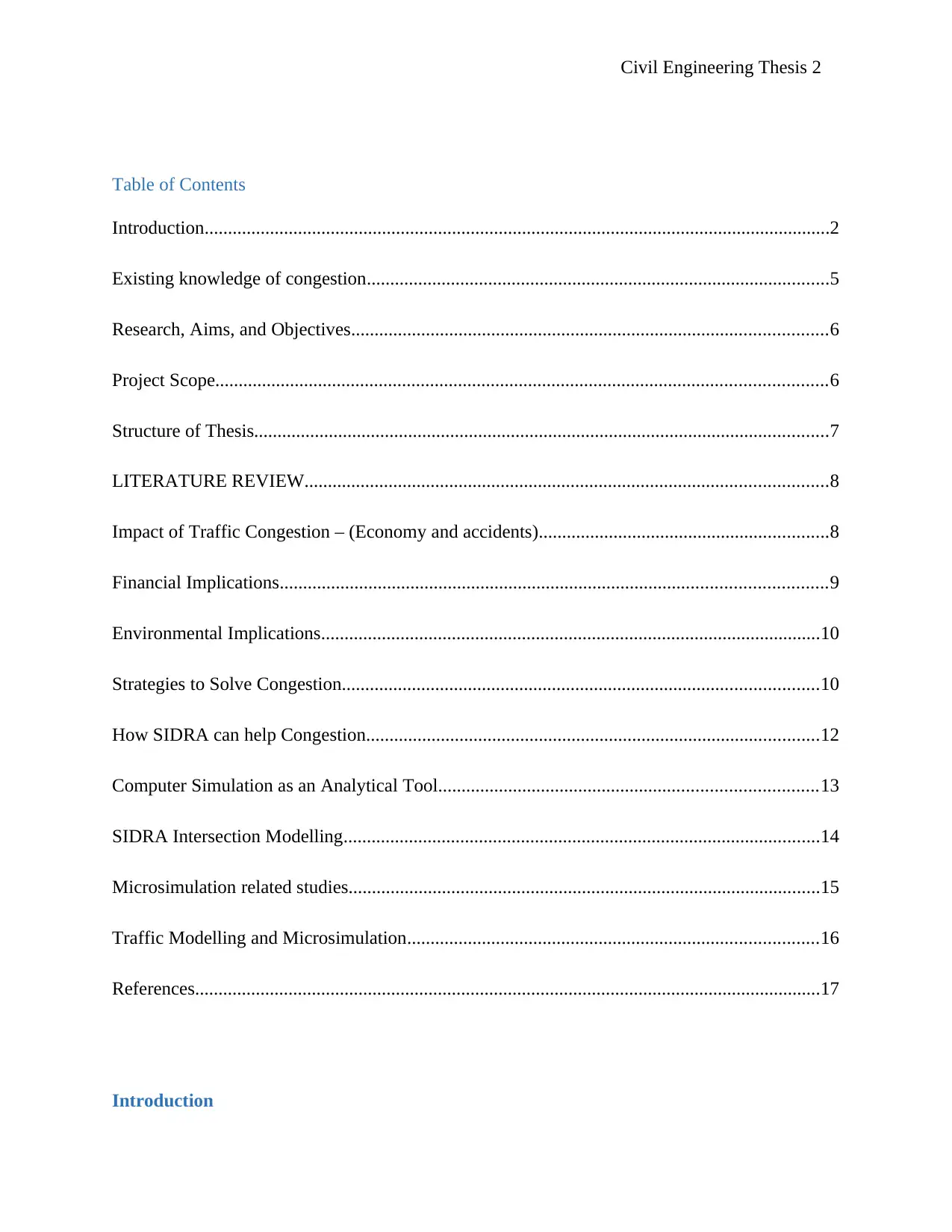
Civil Engineering Thesis 2
Table of Contents
Introduction......................................................................................................................................2
Existing knowledge of congestion...................................................................................................5
Research, Aims, and Objectives......................................................................................................6
Project Scope...................................................................................................................................6
Structure of Thesis...........................................................................................................................7
LITERATURE REVIEW................................................................................................................8
Impact of Traffic Congestion – (Economy and accidents)..............................................................8
Financial Implications.....................................................................................................................9
Environmental Implications...........................................................................................................10
Strategies to Solve Congestion......................................................................................................10
How SIDRA can help Congestion.................................................................................................12
Computer Simulation as an Analytical Tool.................................................................................13
SIDRA Intersection Modelling......................................................................................................14
Microsimulation related studies.....................................................................................................15
Traffic Modelling and Microsimulation........................................................................................16
References......................................................................................................................................17
Introduction
Table of Contents
Introduction......................................................................................................................................2
Existing knowledge of congestion...................................................................................................5
Research, Aims, and Objectives......................................................................................................6
Project Scope...................................................................................................................................6
Structure of Thesis...........................................................................................................................7
LITERATURE REVIEW................................................................................................................8
Impact of Traffic Congestion – (Economy and accidents)..............................................................8
Financial Implications.....................................................................................................................9
Environmental Implications...........................................................................................................10
Strategies to Solve Congestion......................................................................................................10
How SIDRA can help Congestion.................................................................................................12
Computer Simulation as an Analytical Tool.................................................................................13
SIDRA Intersection Modelling......................................................................................................14
Microsimulation related studies.....................................................................................................15
Traffic Modelling and Microsimulation........................................................................................16
References......................................................................................................................................17
Introduction
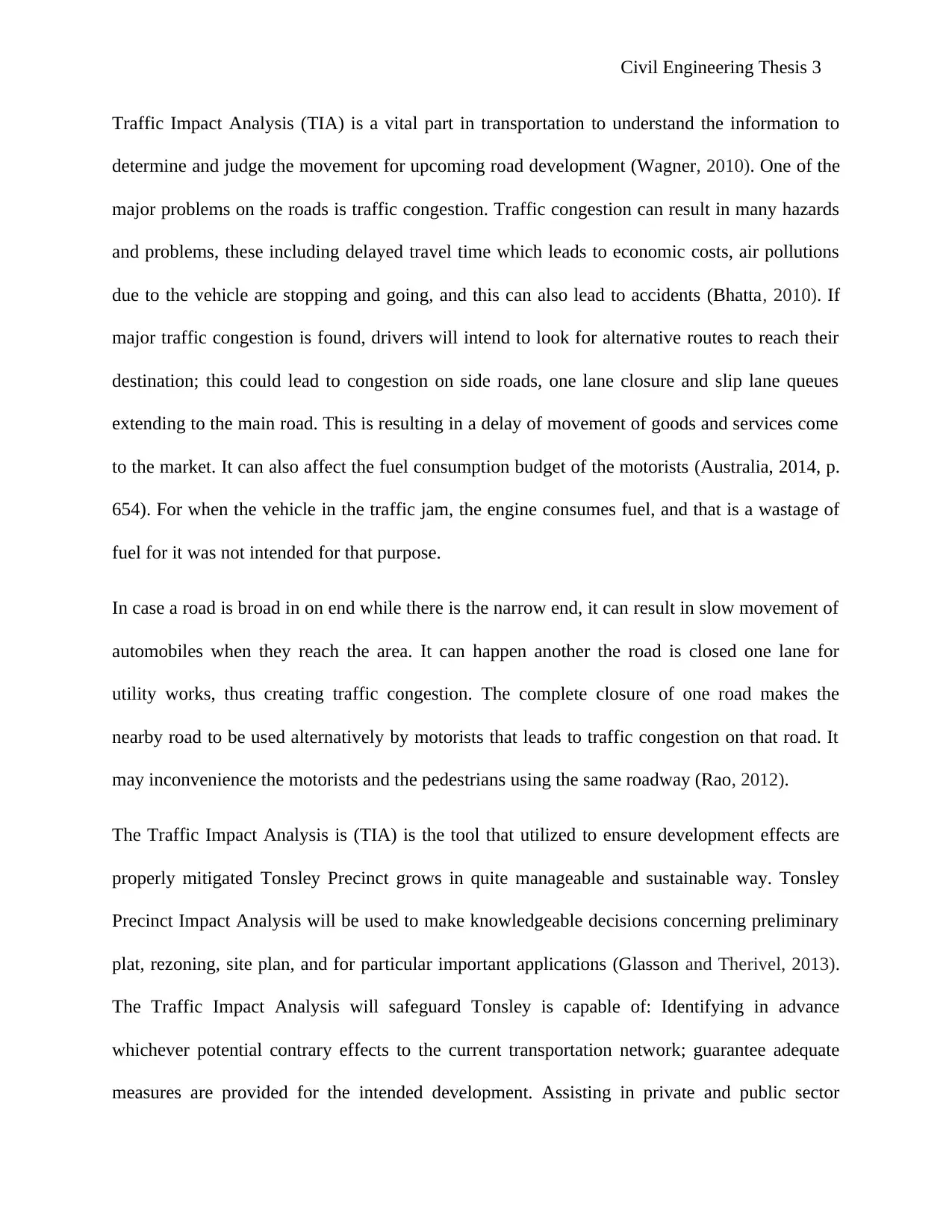
Civil Engineering Thesis 3
Traffic Impact Analysis (TIA) is a vital part in transportation to understand the information to
determine and judge the movement for upcoming road development (Wagner, 2010). One of the
major problems on the roads is traffic congestion. Traffic congestion can result in many hazards
and problems, these including delayed travel time which leads to economic costs, air pollutions
due to the vehicle are stopping and going, and this can also lead to accidents (Bhatta, 2010). If
major traffic congestion is found, drivers will intend to look for alternative routes to reach their
destination; this could lead to congestion on side roads, one lane closure and slip lane queues
extending to the main road. This is resulting in a delay of movement of goods and services come
to the market. It can also affect the fuel consumption budget of the motorists (Australia, 2014, p.
654). For when the vehicle in the traffic jam, the engine consumes fuel, and that is a wastage of
fuel for it was not intended for that purpose.
In case a road is broad in on end while there is the narrow end, it can result in slow movement of
automobiles when they reach the area. It can happen another the road is closed one lane for
utility works, thus creating traffic congestion. The complete closure of one road makes the
nearby road to be used alternatively by motorists that leads to traffic congestion on that road. It
may inconvenience the motorists and the pedestrians using the same roadway (Rao, 2012).
The Traffic Impact Analysis is (TIA) is the tool that utilized to ensure development effects are
properly mitigated Tonsley Precinct grows in quite manageable and sustainable way. Tonsley
Precinct Impact Analysis will be used to make knowledgeable decisions concerning preliminary
plat, rezoning, site plan, and for particular important applications (Glasson and Therivel, 2013).
The Traffic Impact Analysis will safeguard Tonsley is capable of: Identifying in advance
whichever potential contrary effects to the current transportation network; guarantee adequate
measures are provided for the intended development. Assisting in private and public sector
Traffic Impact Analysis (TIA) is a vital part in transportation to understand the information to
determine and judge the movement for upcoming road development (Wagner, 2010). One of the
major problems on the roads is traffic congestion. Traffic congestion can result in many hazards
and problems, these including delayed travel time which leads to economic costs, air pollutions
due to the vehicle are stopping and going, and this can also lead to accidents (Bhatta, 2010). If
major traffic congestion is found, drivers will intend to look for alternative routes to reach their
destination; this could lead to congestion on side roads, one lane closure and slip lane queues
extending to the main road. This is resulting in a delay of movement of goods and services come
to the market. It can also affect the fuel consumption budget of the motorists (Australia, 2014, p.
654). For when the vehicle in the traffic jam, the engine consumes fuel, and that is a wastage of
fuel for it was not intended for that purpose.
In case a road is broad in on end while there is the narrow end, it can result in slow movement of
automobiles when they reach the area. It can happen another the road is closed one lane for
utility works, thus creating traffic congestion. The complete closure of one road makes the
nearby road to be used alternatively by motorists that leads to traffic congestion on that road. It
may inconvenience the motorists and the pedestrians using the same roadway (Rao, 2012).
The Traffic Impact Analysis is (TIA) is the tool that utilized to ensure development effects are
properly mitigated Tonsley Precinct grows in quite manageable and sustainable way. Tonsley
Precinct Impact Analysis will be used to make knowledgeable decisions concerning preliminary
plat, rezoning, site plan, and for particular important applications (Glasson and Therivel, 2013).
The Traffic Impact Analysis will safeguard Tonsley is capable of: Identifying in advance
whichever potential contrary effects to the current transportation network; guarantee adequate
measures are provided for the intended development. Assisting in private and public sector
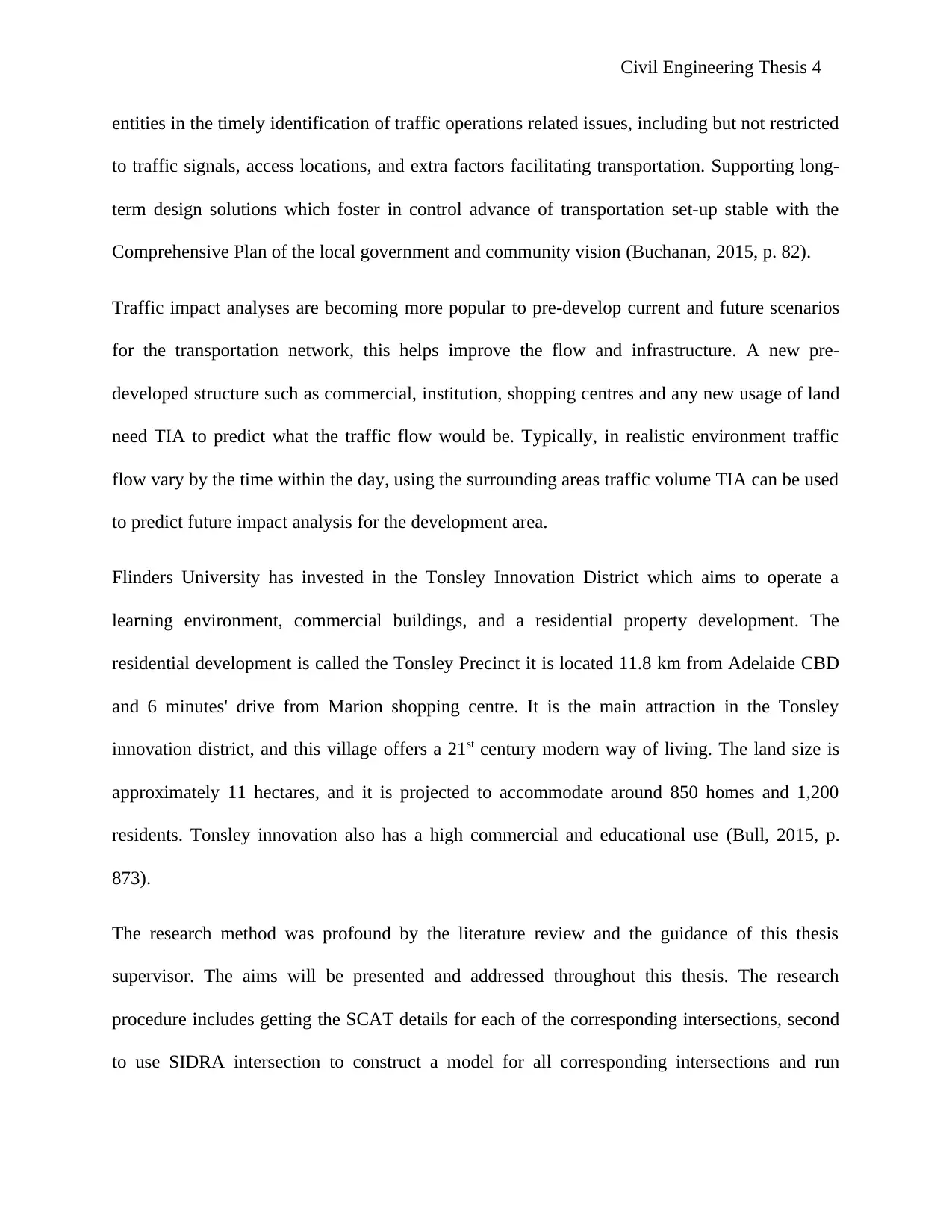
Civil Engineering Thesis 4
entities in the timely identification of traffic operations related issues, including but not restricted
to traffic signals, access locations, and extra factors facilitating transportation. Supporting long-
term design solutions which foster in control advance of transportation set-up stable with the
Comprehensive Plan of the local government and community vision (Buchanan, 2015, p. 82).
Traffic impact analyses are becoming more popular to pre-develop current and future scenarios
for the transportation network, this helps improve the flow and infrastructure. A new pre-
developed structure such as commercial, institution, shopping centres and any new usage of land
need TIA to predict what the traffic flow would be. Typically, in realistic environment traffic
flow vary by the time within the day, using the surrounding areas traffic volume TIA can be used
to predict future impact analysis for the development area.
Flinders University has invested in the Tonsley Innovation District which aims to operate a
learning environment, commercial buildings, and a residential property development. The
residential development is called the Tonsley Precinct it is located 11.8 km from Adelaide CBD
and 6 minutes' drive from Marion shopping centre. It is the main attraction in the Tonsley
innovation district, and this village offers a 21st century modern way of living. The land size is
approximately 11 hectares, and it is projected to accommodate around 850 homes and 1,200
residents. Tonsley innovation also has a high commercial and educational use (Bull, 2015, p.
873).
The research method was profound by the literature review and the guidance of this thesis
supervisor. The aims will be presented and addressed throughout this thesis. The research
procedure includes getting the SCAT details for each of the corresponding intersections, second
to use SIDRA intersection to construct a model for all corresponding intersections and run
entities in the timely identification of traffic operations related issues, including but not restricted
to traffic signals, access locations, and extra factors facilitating transportation. Supporting long-
term design solutions which foster in control advance of transportation set-up stable with the
Comprehensive Plan of the local government and community vision (Buchanan, 2015, p. 82).
Traffic impact analyses are becoming more popular to pre-develop current and future scenarios
for the transportation network, this helps improve the flow and infrastructure. A new pre-
developed structure such as commercial, institution, shopping centres and any new usage of land
need TIA to predict what the traffic flow would be. Typically, in realistic environment traffic
flow vary by the time within the day, using the surrounding areas traffic volume TIA can be used
to predict future impact analysis for the development area.
Flinders University has invested in the Tonsley Innovation District which aims to operate a
learning environment, commercial buildings, and a residential property development. The
residential development is called the Tonsley Precinct it is located 11.8 km from Adelaide CBD
and 6 minutes' drive from Marion shopping centre. It is the main attraction in the Tonsley
innovation district, and this village offers a 21st century modern way of living. The land size is
approximately 11 hectares, and it is projected to accommodate around 850 homes and 1,200
residents. Tonsley innovation also has a high commercial and educational use (Bull, 2015, p.
873).
The research method was profound by the literature review and the guidance of this thesis
supervisor. The aims will be presented and addressed throughout this thesis. The research
procedure includes getting the SCAT details for each of the corresponding intersections, second
to use SIDRA intersection to construct a model for all corresponding intersections and run
Secure Best Marks with AI Grader
Need help grading? Try our AI Grader for instant feedback on your assignments.
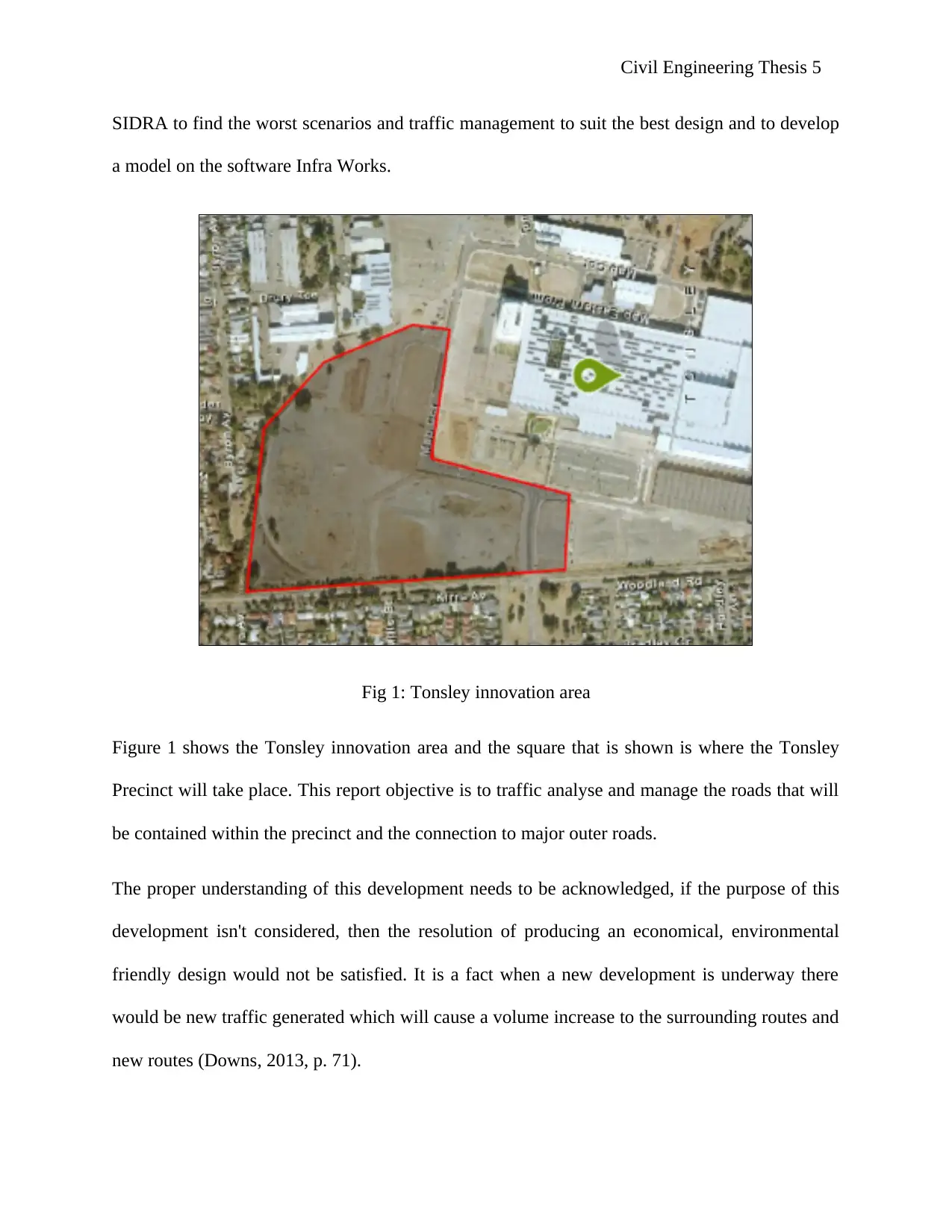
Civil Engineering Thesis 5
SIDRA to find the worst scenarios and traffic management to suit the best design and to develop
a model on the software Infra Works.
Fig 1: Tonsley innovation area
Figure 1 shows the Tonsley innovation area and the square that is shown is where the Tonsley
Precinct will take place. This report objective is to traffic analyse and manage the roads that will
be contained within the precinct and the connection to major outer roads.
The proper understanding of this development needs to be acknowledged, if the purpose of this
development isn't considered, then the resolution of producing an economical, environmental
friendly design would not be satisfied. It is a fact when a new development is underway there
would be new traffic generated which will cause a volume increase to the surrounding routes and
new routes (Downs, 2013, p. 71).
SIDRA to find the worst scenarios and traffic management to suit the best design and to develop
a model on the software Infra Works.
Fig 1: Tonsley innovation area
Figure 1 shows the Tonsley innovation area and the square that is shown is where the Tonsley
Precinct will take place. This report objective is to traffic analyse and manage the roads that will
be contained within the precinct and the connection to major outer roads.
The proper understanding of this development needs to be acknowledged, if the purpose of this
development isn't considered, then the resolution of producing an economical, environmental
friendly design would not be satisfied. It is a fact when a new development is underway there
would be new traffic generated which will cause a volume increase to the surrounding routes and
new routes (Downs, 2013, p. 71).
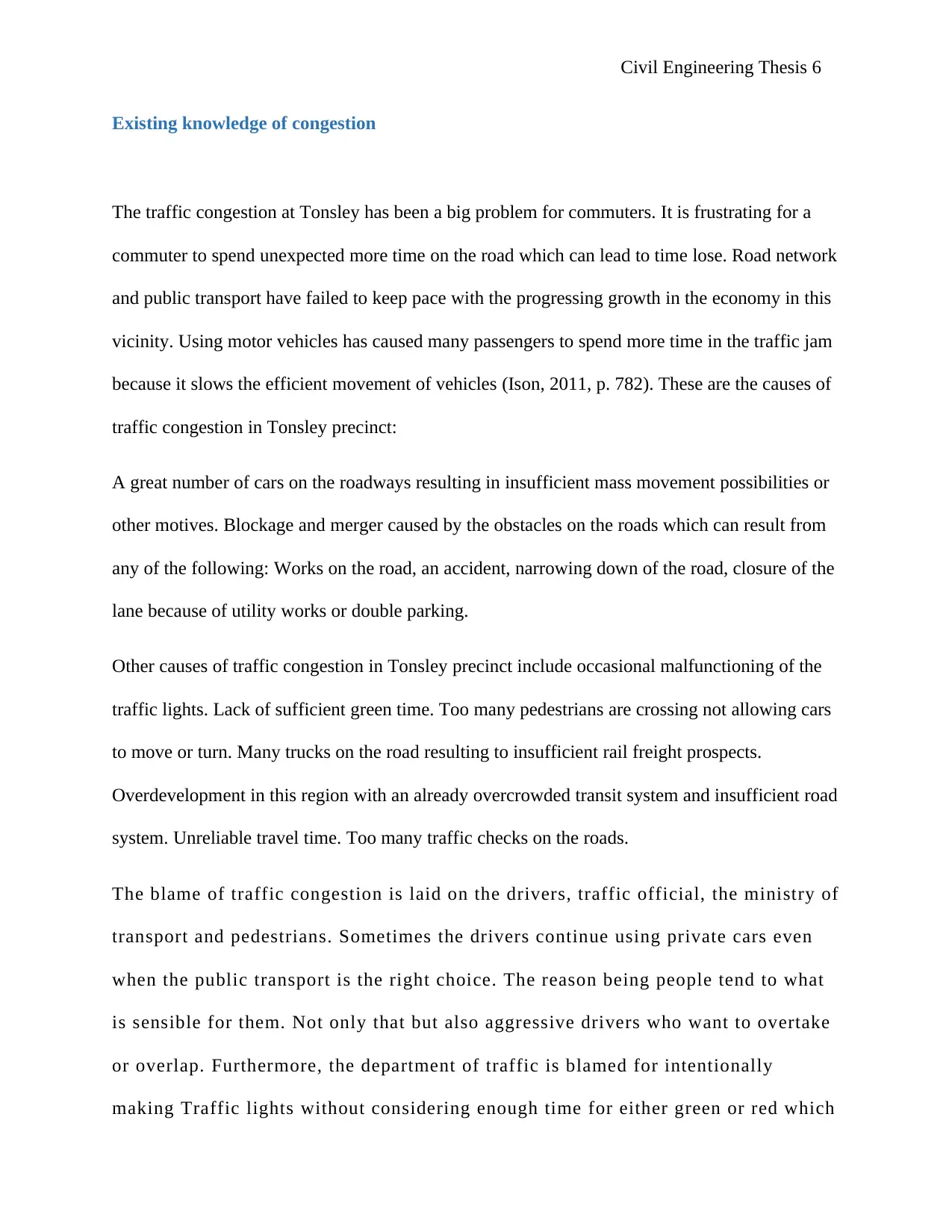
Civil Engineering Thesis 6
Existing knowledge of congestion
The traffic congestion at Tonsley has been a big problem for commuters. It is frustrating for a
commuter to spend unexpected more time on the road which can lead to time lose. Road network
and public transport have failed to keep pace with the progressing growth in the economy in this
vicinity. Using motor vehicles has caused many passengers to spend more time in the traffic jam
because it slows the efficient movement of vehicles (Ison, 2011, p. 782). These are the causes of
traffic congestion in Tonsley precinct:
A great number of cars on the roadways resulting in insufficient mass movement possibilities or
other motives. Blockage and merger caused by the obstacles on the roads which can result from
any of the following: Works on the road, an accident, narrowing down of the road, closure of the
lane because of utility works or double parking.
Other causes of traffic congestion in Tonsley precinct include occasional malfunctioning of the
traffic lights. Lack of sufficient green time. Too many pedestrians are crossing not allowing cars
to move or turn. Many trucks on the road resulting to insufficient rail freight prospects.
Overdevelopment in this region with an already overcrowded transit system and insufficient road
system. Unreliable travel time. Too many traffic checks on the roads.
The blame of traffic congestion is laid on the drivers, traffic official, the ministry of
transport and pedestrians. Sometimes the drivers continue using private cars even
when the public transport is the right choice. The reason being people tend to what
is sensible for them. Not only that but also aggressive drivers who want to overtake
or overlap. Furthermore, the department of traffic is blamed for intentionally
making Traffic lights without considering enough time for either green or red which
Existing knowledge of congestion
The traffic congestion at Tonsley has been a big problem for commuters. It is frustrating for a
commuter to spend unexpected more time on the road which can lead to time lose. Road network
and public transport have failed to keep pace with the progressing growth in the economy in this
vicinity. Using motor vehicles has caused many passengers to spend more time in the traffic jam
because it slows the efficient movement of vehicles (Ison, 2011, p. 782). These are the causes of
traffic congestion in Tonsley precinct:
A great number of cars on the roadways resulting in insufficient mass movement possibilities or
other motives. Blockage and merger caused by the obstacles on the roads which can result from
any of the following: Works on the road, an accident, narrowing down of the road, closure of the
lane because of utility works or double parking.
Other causes of traffic congestion in Tonsley precinct include occasional malfunctioning of the
traffic lights. Lack of sufficient green time. Too many pedestrians are crossing not allowing cars
to move or turn. Many trucks on the road resulting to insufficient rail freight prospects.
Overdevelopment in this region with an already overcrowded transit system and insufficient road
system. Unreliable travel time. Too many traffic checks on the roads.
The blame of traffic congestion is laid on the drivers, traffic official, the ministry of
transport and pedestrians. Sometimes the drivers continue using private cars even
when the public transport is the right choice. The reason being people tend to what
is sensible for them. Not only that but also aggressive drivers who want to overtake
or overlap. Furthermore, the department of traffic is blamed for intentionally
making Traffic lights without considering enough time for either green or red which

Civil Engineering Thesis 7
are automatically working. Sometimes the traffic officers may stop the motor
vehicle near school zones for children to cross the road while the traffic light is
green and that reduces that can lead to traffic congestion. However, the ministry of
transport is blamed when it does not have long-term plans for every road. The
ministry of transport is to increase road capacity as the motorists’ increase so that
to avoid traffic congestions. Even some roads have been widened, but unnecessary
roundabouts can lead to slow transit (Jane, 2011, p. 720).
Research, Aims, and Objectives
The main aim of this research is to investigate and analyse the impact of traffic on the Adelaide
Tonsley precinct. In order to achieve the main aim of the research, various specific objectives
were set to assist in the achievement of the main aim. Some of them include; Analysis of the trip
generation, estimation of time per trip queue, and to analyse the traffic management.
Project Scope
This project is carefully crafted to cover the impact of traffic on the Adelaide Tonsley precinct.
The research strictly focusses on the topic of the research such as to determine the causes of
traffic congestion in Adelaide Tonsley precinct, the financial and environmental implications of
traffic and what are the solutions to the traffic congestion. Various techniques will be used that
relate to the study of traffic such as the use of SIDRA. With that, the research is tied to using the
materials that relate directly to the topic of the research.
Structure of Thesis
This thesis contains the following chapters.
are automatically working. Sometimes the traffic officers may stop the motor
vehicle near school zones for children to cross the road while the traffic light is
green and that reduces that can lead to traffic congestion. However, the ministry of
transport is blamed when it does not have long-term plans for every road. The
ministry of transport is to increase road capacity as the motorists’ increase so that
to avoid traffic congestions. Even some roads have been widened, but unnecessary
roundabouts can lead to slow transit (Jane, 2011, p. 720).
Research, Aims, and Objectives
The main aim of this research is to investigate and analyse the impact of traffic on the Adelaide
Tonsley precinct. In order to achieve the main aim of the research, various specific objectives
were set to assist in the achievement of the main aim. Some of them include; Analysis of the trip
generation, estimation of time per trip queue, and to analyse the traffic management.
Project Scope
This project is carefully crafted to cover the impact of traffic on the Adelaide Tonsley precinct.
The research strictly focusses on the topic of the research such as to determine the causes of
traffic congestion in Adelaide Tonsley precinct, the financial and environmental implications of
traffic and what are the solutions to the traffic congestion. Various techniques will be used that
relate to the study of traffic such as the use of SIDRA. With that, the research is tied to using the
materials that relate directly to the topic of the research.
Structure of Thesis
This thesis contains the following chapters.
Paraphrase This Document
Need a fresh take? Get an instant paraphrase of this document with our AI Paraphraser
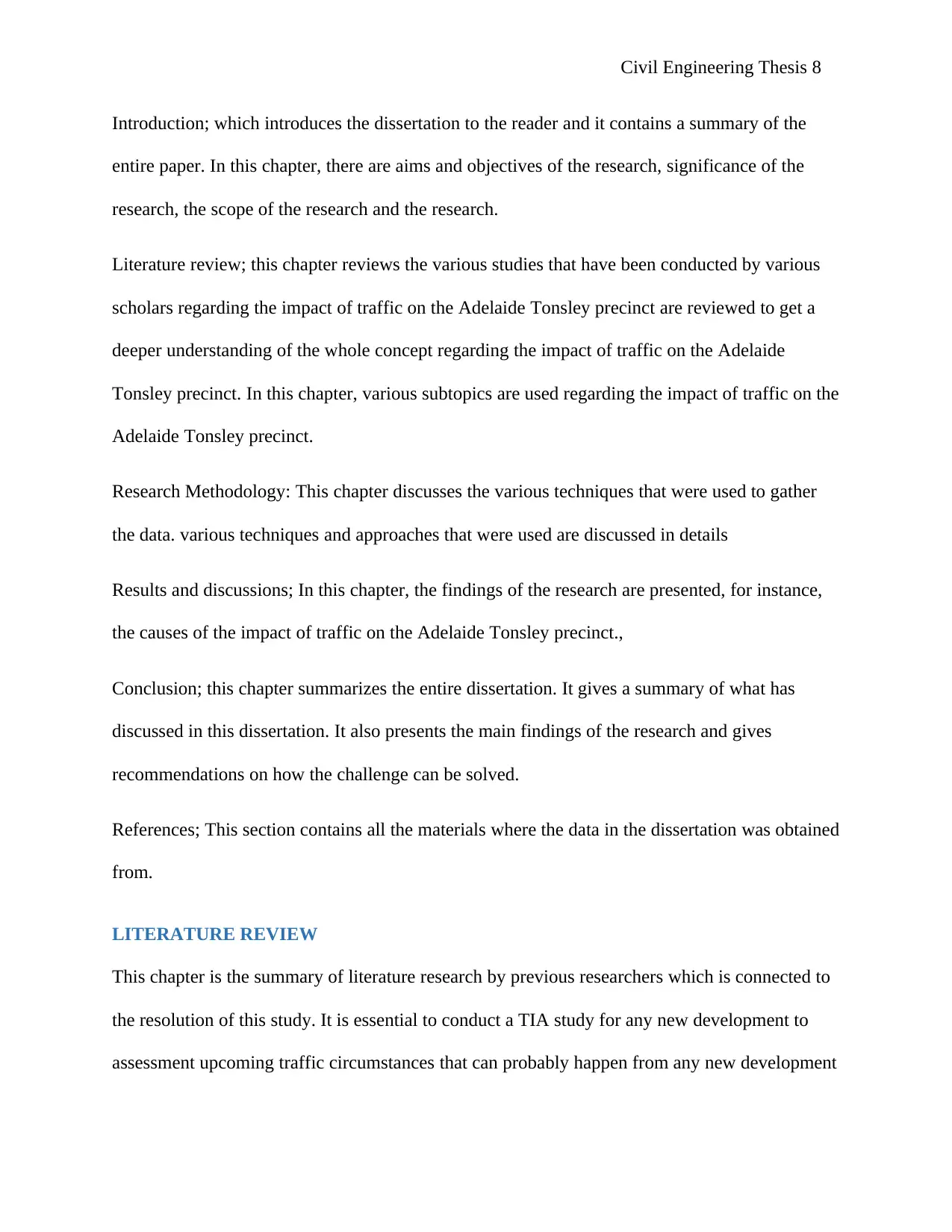
Civil Engineering Thesis 8
Introduction; which introduces the dissertation to the reader and it contains a summary of the
entire paper. In this chapter, there are aims and objectives of the research, significance of the
research, the scope of the research and the research.
Literature review; this chapter reviews the various studies that have been conducted by various
scholars regarding the impact of traffic on the Adelaide Tonsley precinct are reviewed to get a
deeper understanding of the whole concept regarding the impact of traffic on the Adelaide
Tonsley precinct. In this chapter, various subtopics are used regarding the impact of traffic on the
Adelaide Tonsley precinct.
Research Methodology: This chapter discusses the various techniques that were used to gather
the data. various techniques and approaches that were used are discussed in details
Results and discussions; In this chapter, the findings of the research are presented, for instance,
the causes of the impact of traffic on the Adelaide Tonsley precinct.,
Conclusion; this chapter summarizes the entire dissertation. It gives a summary of what has
discussed in this dissertation. It also presents the main findings of the research and gives
recommendations on how the challenge can be solved.
References; This section contains all the materials where the data in the dissertation was obtained
from.
LITERATURE REVIEW
This chapter is the summary of literature research by previous researchers which is connected to
the resolution of this study. It is essential to conduct a TIA study for any new development to
assessment upcoming traffic circumstances that can probably happen from any new development
Introduction; which introduces the dissertation to the reader and it contains a summary of the
entire paper. In this chapter, there are aims and objectives of the research, significance of the
research, the scope of the research and the research.
Literature review; this chapter reviews the various studies that have been conducted by various
scholars regarding the impact of traffic on the Adelaide Tonsley precinct are reviewed to get a
deeper understanding of the whole concept regarding the impact of traffic on the Adelaide
Tonsley precinct. In this chapter, various subtopics are used regarding the impact of traffic on the
Adelaide Tonsley precinct.
Research Methodology: This chapter discusses the various techniques that were used to gather
the data. various techniques and approaches that were used are discussed in details
Results and discussions; In this chapter, the findings of the research are presented, for instance,
the causes of the impact of traffic on the Adelaide Tonsley precinct.,
Conclusion; this chapter summarizes the entire dissertation. It gives a summary of what has
discussed in this dissertation. It also presents the main findings of the research and gives
recommendations on how the challenge can be solved.
References; This section contains all the materials where the data in the dissertation was obtained
from.
LITERATURE REVIEW
This chapter is the summary of literature research by previous researchers which is connected to
the resolution of this study. It is essential to conduct a TIA study for any new development to
assessment upcoming traffic circumstances that can probably happen from any new development
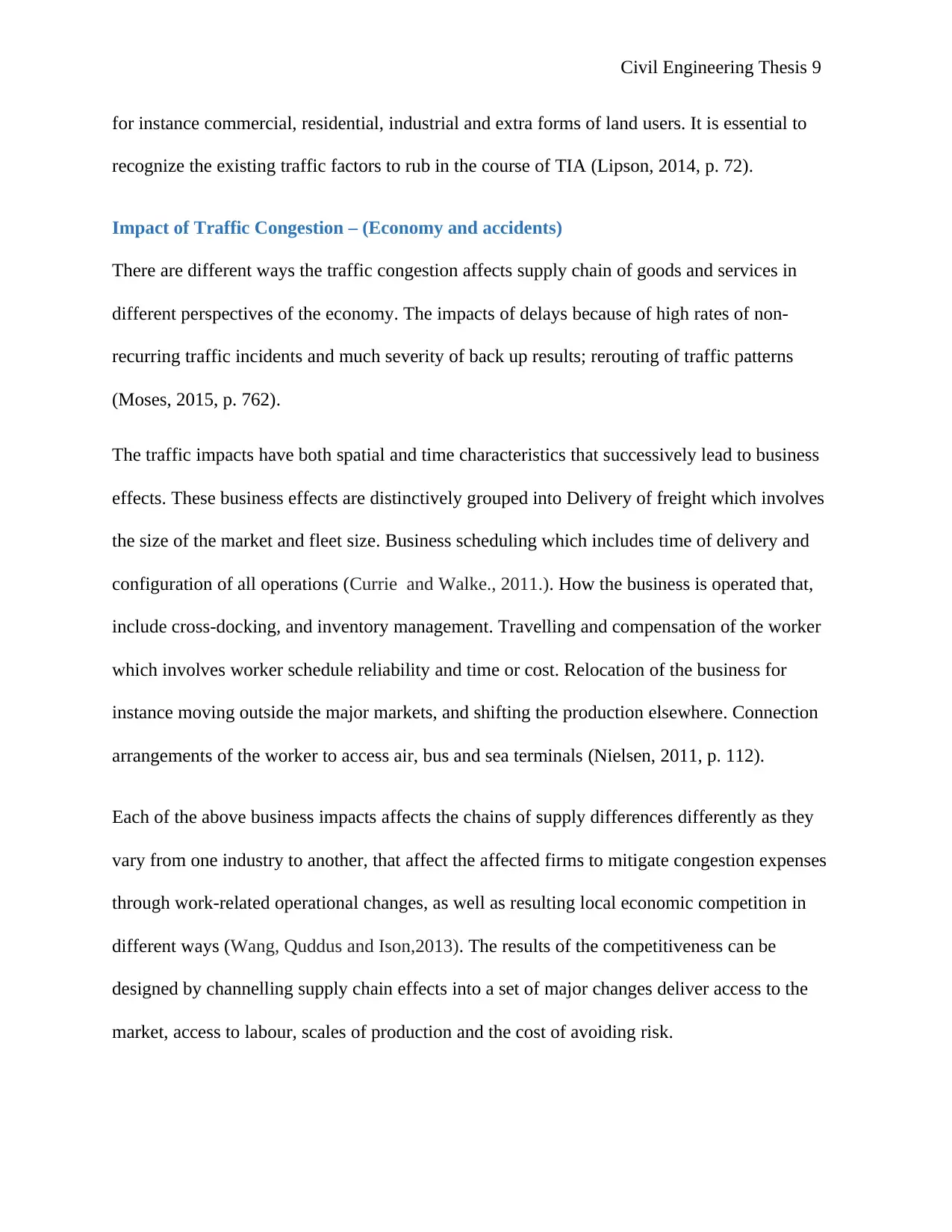
Civil Engineering Thesis 9
for instance commercial, residential, industrial and extra forms of land users. It is essential to
recognize the existing traffic factors to rub in the course of TIA (Lipson, 2014, p. 72).
Impact of Traffic Congestion – (Economy and accidents)
There are different ways the traffic congestion affects supply chain of goods and services in
different perspectives of the economy. The impacts of delays because of high rates of non-
recurring traffic incidents and much severity of back up results; rerouting of traffic patterns
(Moses, 2015, p. 762).
The traffic impacts have both spatial and time characteristics that successively lead to business
effects. These business effects are distinctively grouped into Delivery of freight which involves
the size of the market and fleet size. Business scheduling which includes time of delivery and
configuration of all operations (Currie and Walke., 2011.). How the business is operated that,
include cross-docking, and inventory management. Travelling and compensation of the worker
which involves worker schedule reliability and time or cost. Relocation of the business for
instance moving outside the major markets, and shifting the production elsewhere. Connection
arrangements of the worker to access air, bus and sea terminals (Nielsen, 2011, p. 112).
Each of the above business impacts affects the chains of supply differences differently as they
vary from one industry to another, that affect the affected firms to mitigate congestion expenses
through work-related operational changes, as well as resulting local economic competition in
different ways (Wang, Quddus and Ison,2013). The results of the competitiveness can be
designed by channelling supply chain effects into a set of major changes deliver access to the
market, access to labour, scales of production and the cost of avoiding risk.
for instance commercial, residential, industrial and extra forms of land users. It is essential to
recognize the existing traffic factors to rub in the course of TIA (Lipson, 2014, p. 72).
Impact of Traffic Congestion – (Economy and accidents)
There are different ways the traffic congestion affects supply chain of goods and services in
different perspectives of the economy. The impacts of delays because of high rates of non-
recurring traffic incidents and much severity of back up results; rerouting of traffic patterns
(Moses, 2015, p. 762).
The traffic impacts have both spatial and time characteristics that successively lead to business
effects. These business effects are distinctively grouped into Delivery of freight which involves
the size of the market and fleet size. Business scheduling which includes time of delivery and
configuration of all operations (Currie and Walke., 2011.). How the business is operated that,
include cross-docking, and inventory management. Travelling and compensation of the worker
which involves worker schedule reliability and time or cost. Relocation of the business for
instance moving outside the major markets, and shifting the production elsewhere. Connection
arrangements of the worker to access air, bus and sea terminals (Nielsen, 2011, p. 112).
Each of the above business impacts affects the chains of supply differences differently as they
vary from one industry to another, that affect the affected firms to mitigate congestion expenses
through work-related operational changes, as well as resulting local economic competition in
different ways (Wang, Quddus and Ison,2013). The results of the competitiveness can be
designed by channelling supply chain effects into a set of major changes deliver access to the
market, access to labour, scales of production and the cost of avoiding risk.
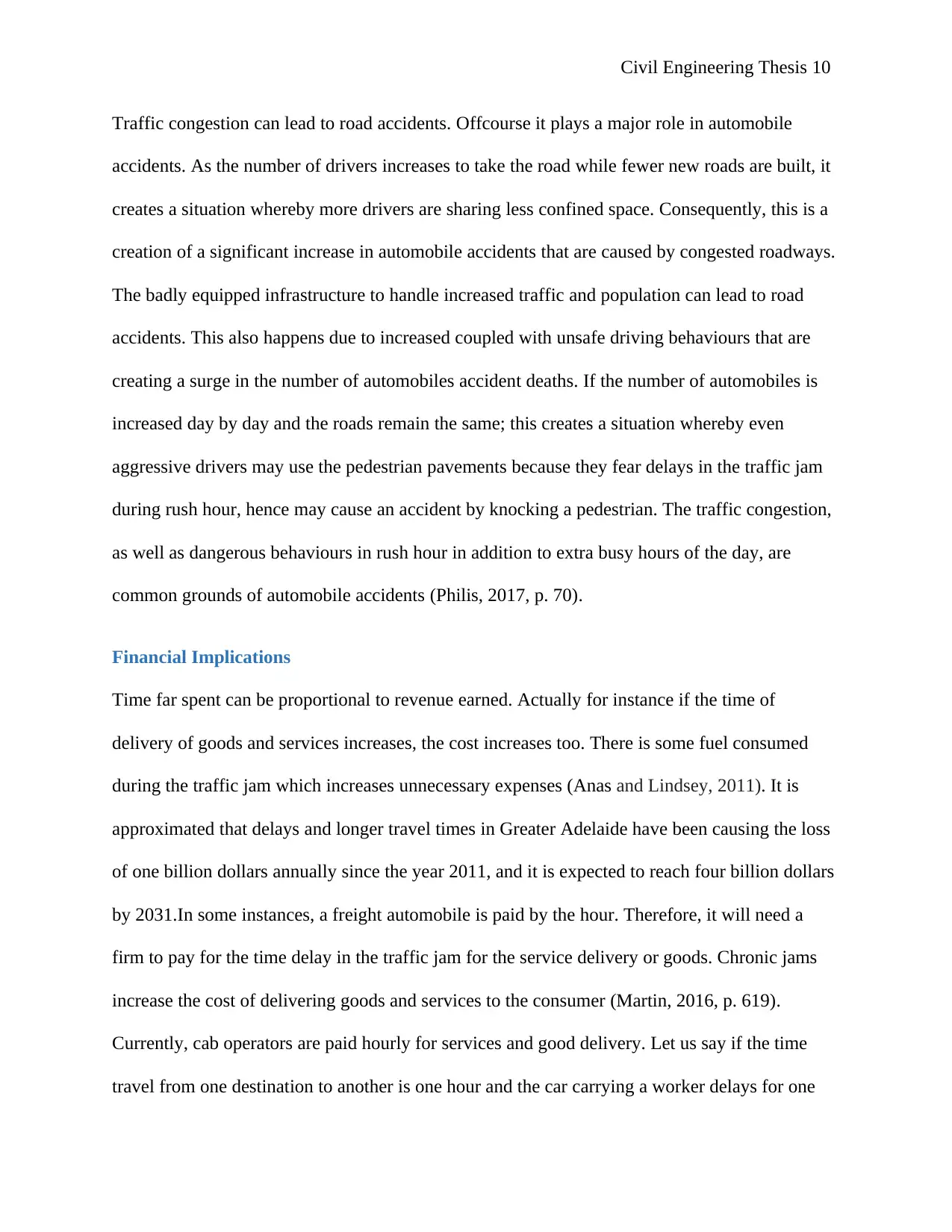
Civil Engineering Thesis 10
Traffic congestion can lead to road accidents. Offcourse it plays a major role in automobile
accidents. As the number of drivers increases to take the road while fewer new roads are built, it
creates a situation whereby more drivers are sharing less confined space. Consequently, this is a
creation of a significant increase in automobile accidents that are caused by congested roadways.
The badly equipped infrastructure to handle increased traffic and population can lead to road
accidents. This also happens due to increased coupled with unsafe driving behaviours that are
creating a surge in the number of automobiles accident deaths. If the number of automobiles is
increased day by day and the roads remain the same; this creates a situation whereby even
aggressive drivers may use the pedestrian pavements because they fear delays in the traffic jam
during rush hour, hence may cause an accident by knocking a pedestrian. The traffic congestion,
as well as dangerous behaviours in rush hour in addition to extra busy hours of the day, are
common grounds of automobile accidents (Philis, 2017, p. 70).
Financial Implications
Time far spent can be proportional to revenue earned. Actually for instance if the time of
delivery of goods and services increases, the cost increases too. There is some fuel consumed
during the traffic jam which increases unnecessary expenses (Anas and Lindsey, 2011). It is
approximated that delays and longer travel times in Greater Adelaide have been causing the loss
of one billion dollars annually since the year 2011, and it is expected to reach four billion dollars
by 2031.In some instances, a freight automobile is paid by the hour. Therefore, it will need a
firm to pay for the time delay in the traffic jam for the service delivery or goods. Chronic jams
increase the cost of delivering goods and services to the consumer (Martin, 2016, p. 619).
Currently, cab operators are paid hourly for services and good delivery. Let us say if the time
travel from one destination to another is one hour and the car carrying a worker delays for one
Traffic congestion can lead to road accidents. Offcourse it plays a major role in automobile
accidents. As the number of drivers increases to take the road while fewer new roads are built, it
creates a situation whereby more drivers are sharing less confined space. Consequently, this is a
creation of a significant increase in automobile accidents that are caused by congested roadways.
The badly equipped infrastructure to handle increased traffic and population can lead to road
accidents. This also happens due to increased coupled with unsafe driving behaviours that are
creating a surge in the number of automobiles accident deaths. If the number of automobiles is
increased day by day and the roads remain the same; this creates a situation whereby even
aggressive drivers may use the pedestrian pavements because they fear delays in the traffic jam
during rush hour, hence may cause an accident by knocking a pedestrian. The traffic congestion,
as well as dangerous behaviours in rush hour in addition to extra busy hours of the day, are
common grounds of automobile accidents (Philis, 2017, p. 70).
Financial Implications
Time far spent can be proportional to revenue earned. Actually for instance if the time of
delivery of goods and services increases, the cost increases too. There is some fuel consumed
during the traffic jam which increases unnecessary expenses (Anas and Lindsey, 2011). It is
approximated that delays and longer travel times in Greater Adelaide have been causing the loss
of one billion dollars annually since the year 2011, and it is expected to reach four billion dollars
by 2031.In some instances, a freight automobile is paid by the hour. Therefore, it will need a
firm to pay for the time delay in the traffic jam for the service delivery or goods. Chronic jams
increase the cost of delivering goods and services to the consumer (Martin, 2016, p. 619).
Currently, cab operators are paid hourly for services and good delivery. Let us say if the time
travel from one destination to another is one hour and the car carrying a worker delays for one
Secure Best Marks with AI Grader
Need help grading? Try our AI Grader for instant feedback on your assignments.
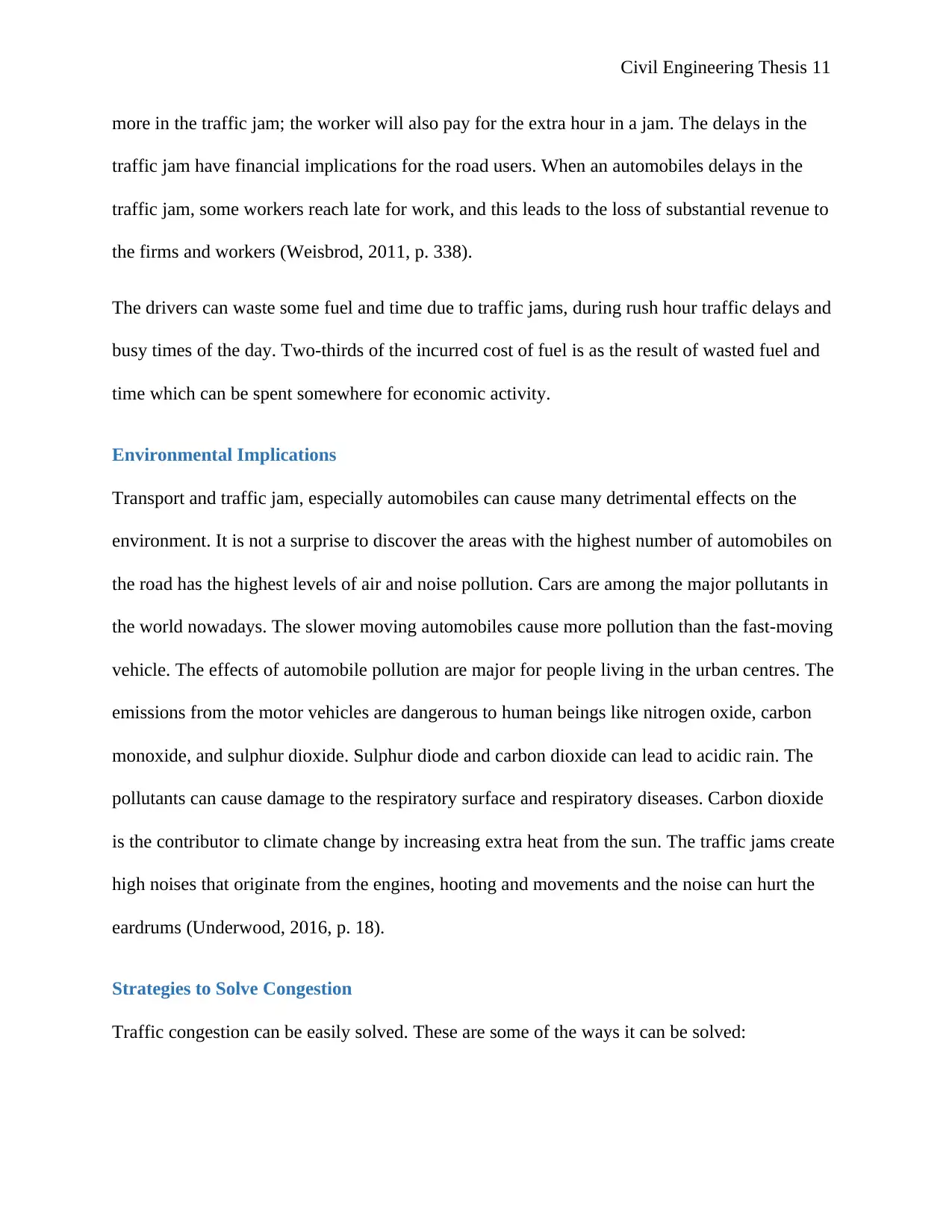
Civil Engineering Thesis 11
more in the traffic jam; the worker will also pay for the extra hour in a jam. The delays in the
traffic jam have financial implications for the road users. When an automobiles delays in the
traffic jam, some workers reach late for work, and this leads to the loss of substantial revenue to
the firms and workers (Weisbrod, 2011, p. 338).
The drivers can waste some fuel and time due to traffic jams, during rush hour traffic delays and
busy times of the day. Two-thirds of the incurred cost of fuel is as the result of wasted fuel and
time which can be spent somewhere for economic activity.
Environmental Implications
Transport and traffic jam, especially automobiles can cause many detrimental effects on the
environment. It is not a surprise to discover the areas with the highest number of automobiles on
the road has the highest levels of air and noise pollution. Cars are among the major pollutants in
the world nowadays. The slower moving automobiles cause more pollution than the fast-moving
vehicle. The effects of automobile pollution are major for people living in the urban centres. The
emissions from the motor vehicles are dangerous to human beings like nitrogen oxide, carbon
monoxide, and sulphur dioxide. Sulphur diode and carbon dioxide can lead to acidic rain. The
pollutants can cause damage to the respiratory surface and respiratory diseases. Carbon dioxide
is the contributor to climate change by increasing extra heat from the sun. The traffic jams create
high noises that originate from the engines, hooting and movements and the noise can hurt the
eardrums (Underwood, 2016, p. 18).
Strategies to Solve Congestion
Traffic congestion can be easily solved. These are some of the ways it can be solved:
more in the traffic jam; the worker will also pay for the extra hour in a jam. The delays in the
traffic jam have financial implications for the road users. When an automobiles delays in the
traffic jam, some workers reach late for work, and this leads to the loss of substantial revenue to
the firms and workers (Weisbrod, 2011, p. 338).
The drivers can waste some fuel and time due to traffic jams, during rush hour traffic delays and
busy times of the day. Two-thirds of the incurred cost of fuel is as the result of wasted fuel and
time which can be spent somewhere for economic activity.
Environmental Implications
Transport and traffic jam, especially automobiles can cause many detrimental effects on the
environment. It is not a surprise to discover the areas with the highest number of automobiles on
the road has the highest levels of air and noise pollution. Cars are among the major pollutants in
the world nowadays. The slower moving automobiles cause more pollution than the fast-moving
vehicle. The effects of automobile pollution are major for people living in the urban centres. The
emissions from the motor vehicles are dangerous to human beings like nitrogen oxide, carbon
monoxide, and sulphur dioxide. Sulphur diode and carbon dioxide can lead to acidic rain. The
pollutants can cause damage to the respiratory surface and respiratory diseases. Carbon dioxide
is the contributor to climate change by increasing extra heat from the sun. The traffic jams create
high noises that originate from the engines, hooting and movements and the noise can hurt the
eardrums (Underwood, 2016, p. 18).
Strategies to Solve Congestion
Traffic congestion can be easily solved. These are some of the ways it can be solved:
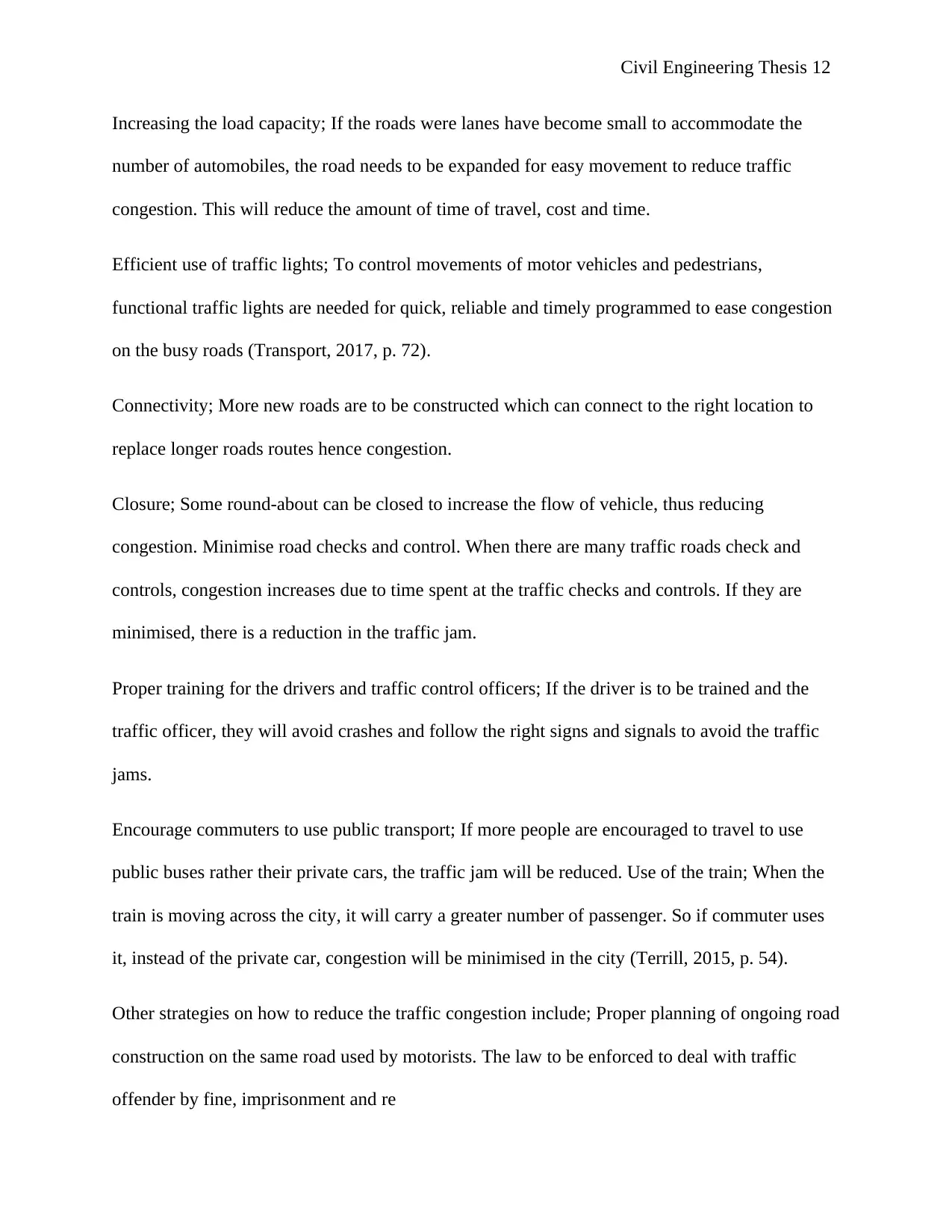
Civil Engineering Thesis 12
Increasing the load capacity; If the roads were lanes have become small to accommodate the
number of automobiles, the road needs to be expanded for easy movement to reduce traffic
congestion. This will reduce the amount of time of travel, cost and time.
Efficient use of traffic lights; To control movements of motor vehicles and pedestrians,
functional traffic lights are needed for quick, reliable and timely programmed to ease congestion
on the busy roads (Transport, 2017, p. 72).
Connectivity; More new roads are to be constructed which can connect to the right location to
replace longer roads routes hence congestion.
Closure; Some round-about can be closed to increase the flow of vehicle, thus reducing
congestion. Minimise road checks and control. When there are many traffic roads check and
controls, congestion increases due to time spent at the traffic checks and controls. If they are
minimised, there is a reduction in the traffic jam.
Proper training for the drivers and traffic control officers; If the driver is to be trained and the
traffic officer, they will avoid crashes and follow the right signs and signals to avoid the traffic
jams.
Encourage commuters to use public transport; If more people are encouraged to travel to use
public buses rather their private cars, the traffic jam will be reduced. Use of the train; When the
train is moving across the city, it will carry a greater number of passenger. So if commuter uses
it, instead of the private car, congestion will be minimised in the city (Terrill, 2015, p. 54).
Other strategies on how to reduce the traffic congestion include; Proper planning of ongoing road
construction on the same road used by motorists. The law to be enforced to deal with traffic
offender by fine, imprisonment and re
Increasing the load capacity; If the roads were lanes have become small to accommodate the
number of automobiles, the road needs to be expanded for easy movement to reduce traffic
congestion. This will reduce the amount of time of travel, cost and time.
Efficient use of traffic lights; To control movements of motor vehicles and pedestrians,
functional traffic lights are needed for quick, reliable and timely programmed to ease congestion
on the busy roads (Transport, 2017, p. 72).
Connectivity; More new roads are to be constructed which can connect to the right location to
replace longer roads routes hence congestion.
Closure; Some round-about can be closed to increase the flow of vehicle, thus reducing
congestion. Minimise road checks and control. When there are many traffic roads check and
controls, congestion increases due to time spent at the traffic checks and controls. If they are
minimised, there is a reduction in the traffic jam.
Proper training for the drivers and traffic control officers; If the driver is to be trained and the
traffic officer, they will avoid crashes and follow the right signs and signals to avoid the traffic
jams.
Encourage commuters to use public transport; If more people are encouraged to travel to use
public buses rather their private cars, the traffic jam will be reduced. Use of the train; When the
train is moving across the city, it will carry a greater number of passenger. So if commuter uses
it, instead of the private car, congestion will be minimised in the city (Terrill, 2015, p. 54).
Other strategies on how to reduce the traffic congestion include; Proper planning of ongoing road
construction on the same road used by motorists. The law to be enforced to deal with traffic
offender by fine, imprisonment and re
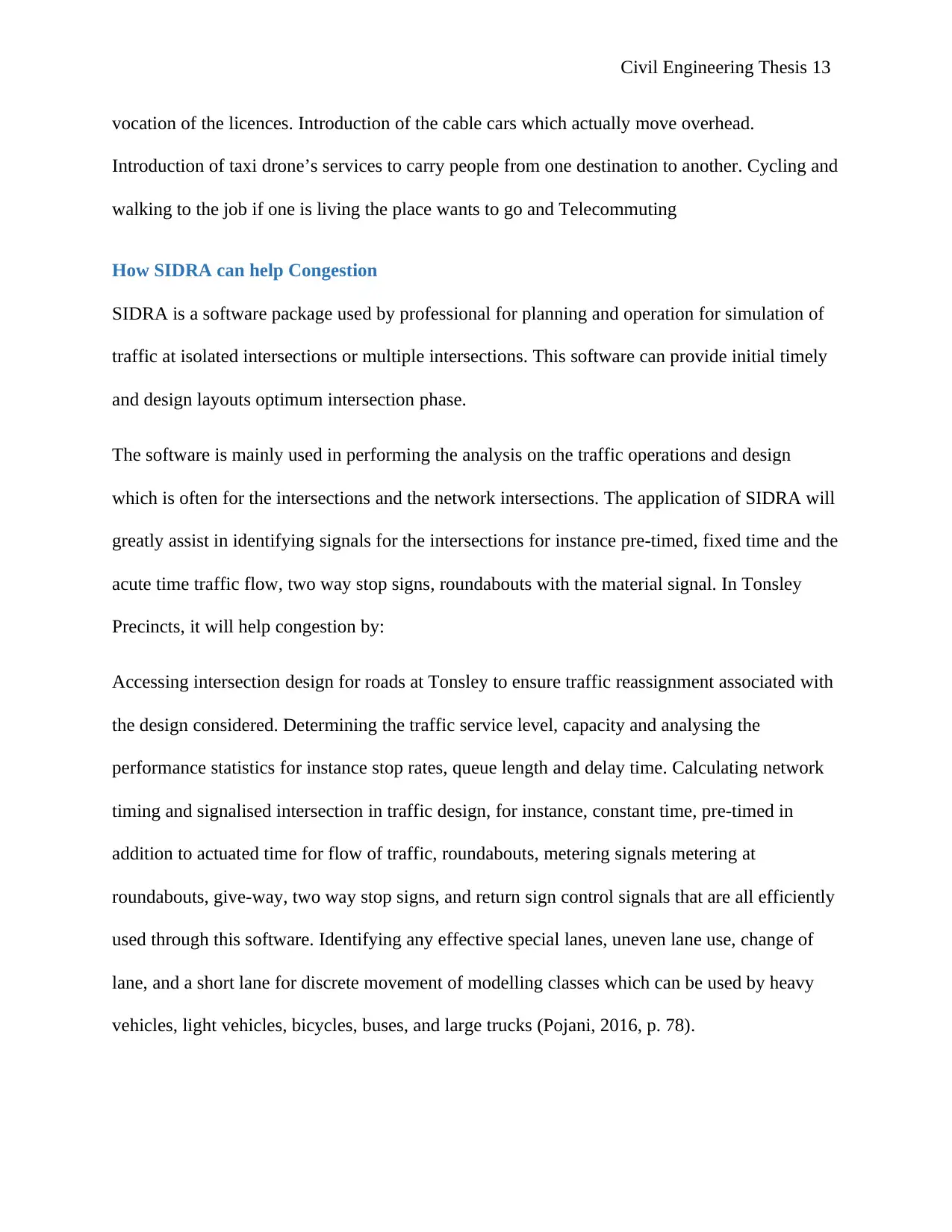
Civil Engineering Thesis 13
vocation of the licences. Introduction of the cable cars which actually move overhead.
Introduction of taxi drone’s services to carry people from one destination to another. Cycling and
walking to the job if one is living the place wants to go and Telecommuting
How SIDRA can help Congestion
SIDRA is a software package used by professional for planning and operation for simulation of
traffic at isolated intersections or multiple intersections. This software can provide initial timely
and design layouts optimum intersection phase.
The software is mainly used in performing the analysis on the traffic operations and design
which is often for the intersections and the network intersections. The application of SIDRA will
greatly assist in identifying signals for the intersections for instance pre-timed, fixed time and the
acute time traffic flow, two way stop signs, roundabouts with the material signal. In Tonsley
Precincts, it will help congestion by:
Accessing intersection design for roads at Tonsley to ensure traffic reassignment associated with
the design considered. Determining the traffic service level, capacity and analysing the
performance statistics for instance stop rates, queue length and delay time. Calculating network
timing and signalised intersection in traffic design, for instance, constant time, pre-timed in
addition to actuated time for flow of traffic, roundabouts, metering signals metering at
roundabouts, give-way, two way stop signs, and return sign control signals that are all efficiently
used through this software. Identifying any effective special lanes, uneven lane use, change of
lane, and a short lane for discrete movement of modelling classes which can be used by heavy
vehicles, light vehicles, bicycles, buses, and large trucks (Pojani, 2016, p. 78).
vocation of the licences. Introduction of the cable cars which actually move overhead.
Introduction of taxi drone’s services to carry people from one destination to another. Cycling and
walking to the job if one is living the place wants to go and Telecommuting
How SIDRA can help Congestion
SIDRA is a software package used by professional for planning and operation for simulation of
traffic at isolated intersections or multiple intersections. This software can provide initial timely
and design layouts optimum intersection phase.
The software is mainly used in performing the analysis on the traffic operations and design
which is often for the intersections and the network intersections. The application of SIDRA will
greatly assist in identifying signals for the intersections for instance pre-timed, fixed time and the
acute time traffic flow, two way stop signs, roundabouts with the material signal. In Tonsley
Precincts, it will help congestion by:
Accessing intersection design for roads at Tonsley to ensure traffic reassignment associated with
the design considered. Determining the traffic service level, capacity and analysing the
performance statistics for instance stop rates, queue length and delay time. Calculating network
timing and signalised intersection in traffic design, for instance, constant time, pre-timed in
addition to actuated time for flow of traffic, roundabouts, metering signals metering at
roundabouts, give-way, two way stop signs, and return sign control signals that are all efficiently
used through this software. Identifying any effective special lanes, uneven lane use, change of
lane, and a short lane for discrete movement of modelling classes which can be used by heavy
vehicles, light vehicles, bicycles, buses, and large trucks (Pojani, 2016, p. 78).
Paraphrase This Document
Need a fresh take? Get an instant paraphrase of this document with our AI Paraphraser
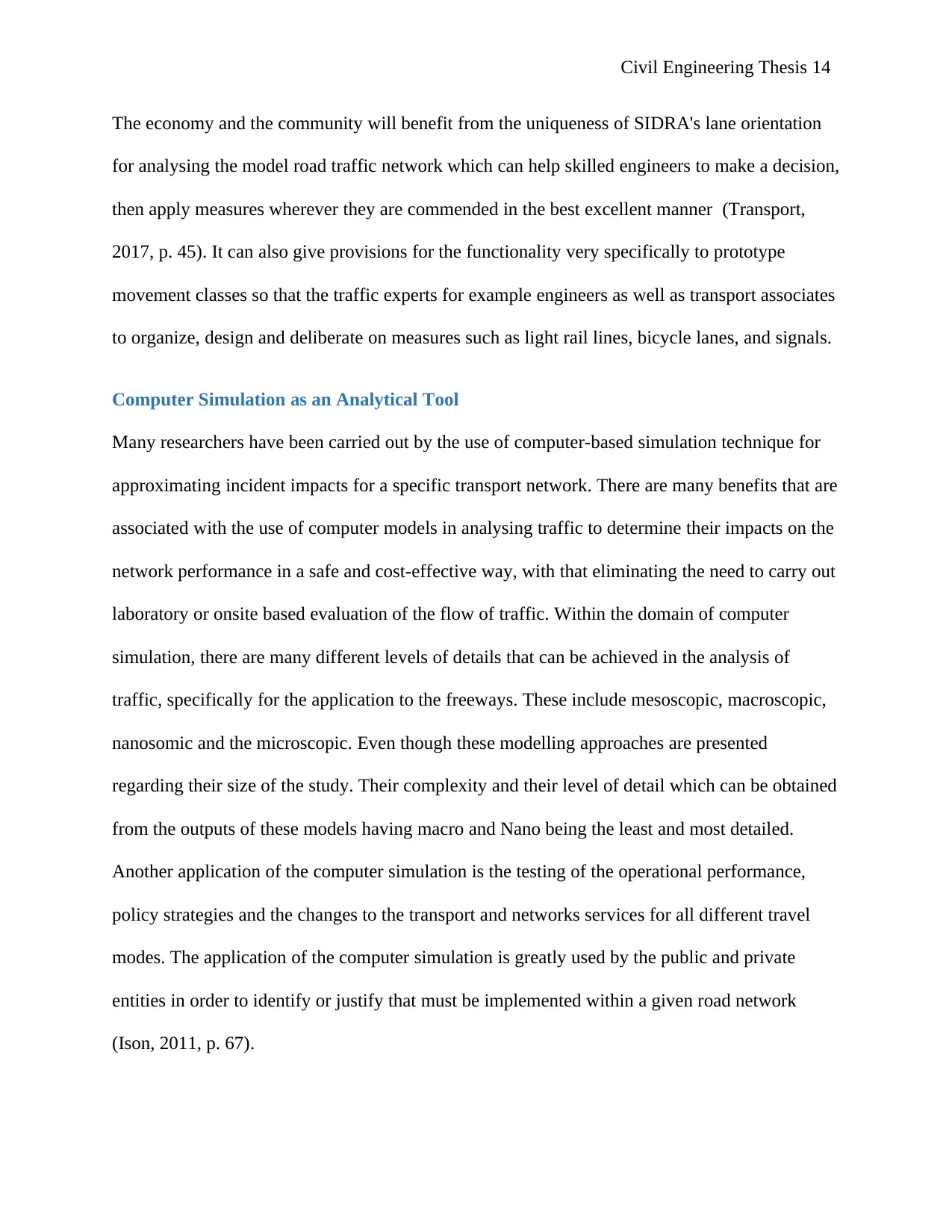
Civil Engineering Thesis 14
The economy and the community will benefit from the uniqueness of SIDRA's lane orientation
for analysing the model road traffic network which can help skilled engineers to make a decision,
then apply measures wherever they are commended in the best excellent manner (Transport,
2017, p. 45). It can also give provisions for the functionality very specifically to prototype
movement classes so that the traffic experts for example engineers as well as transport associates
to organize, design and deliberate on measures such as light rail lines, bicycle lanes, and signals.
Computer Simulation as an Analytical Tool
Many researchers have been carried out by the use of computer-based simulation technique for
approximating incident impacts for a specific transport network. There are many benefits that are
associated with the use of computer models in analysing traffic to determine their impacts on the
network performance in a safe and cost-effective way, with that eliminating the need to carry out
laboratory or onsite based evaluation of the flow of traffic. Within the domain of computer
simulation, there are many different levels of details that can be achieved in the analysis of
traffic, specifically for the application to the freeways. These include mesoscopic, macroscopic,
nanosomic and the microscopic. Even though these modelling approaches are presented
regarding their size of the study. Their complexity and their level of detail which can be obtained
from the outputs of these models having macro and Nano being the least and most detailed.
Another application of the computer simulation is the testing of the operational performance,
policy strategies and the changes to the transport and networks services for all different travel
modes. The application of the computer simulation is greatly used by the public and private
entities in order to identify or justify that must be implemented within a given road network
(Ison, 2011, p. 67).
The economy and the community will benefit from the uniqueness of SIDRA's lane orientation
for analysing the model road traffic network which can help skilled engineers to make a decision,
then apply measures wherever they are commended in the best excellent manner (Transport,
2017, p. 45). It can also give provisions for the functionality very specifically to prototype
movement classes so that the traffic experts for example engineers as well as transport associates
to organize, design and deliberate on measures such as light rail lines, bicycle lanes, and signals.
Computer Simulation as an Analytical Tool
Many researchers have been carried out by the use of computer-based simulation technique for
approximating incident impacts for a specific transport network. There are many benefits that are
associated with the use of computer models in analysing traffic to determine their impacts on the
network performance in a safe and cost-effective way, with that eliminating the need to carry out
laboratory or onsite based evaluation of the flow of traffic. Within the domain of computer
simulation, there are many different levels of details that can be achieved in the analysis of
traffic, specifically for the application to the freeways. These include mesoscopic, macroscopic,
nanosomic and the microscopic. Even though these modelling approaches are presented
regarding their size of the study. Their complexity and their level of detail which can be obtained
from the outputs of these models having macro and Nano being the least and most detailed.
Another application of the computer simulation is the testing of the operational performance,
policy strategies and the changes to the transport and networks services for all different travel
modes. The application of the computer simulation is greatly used by the public and private
entities in order to identify or justify that must be implemented within a given road network
(Ison, 2011, p. 67).
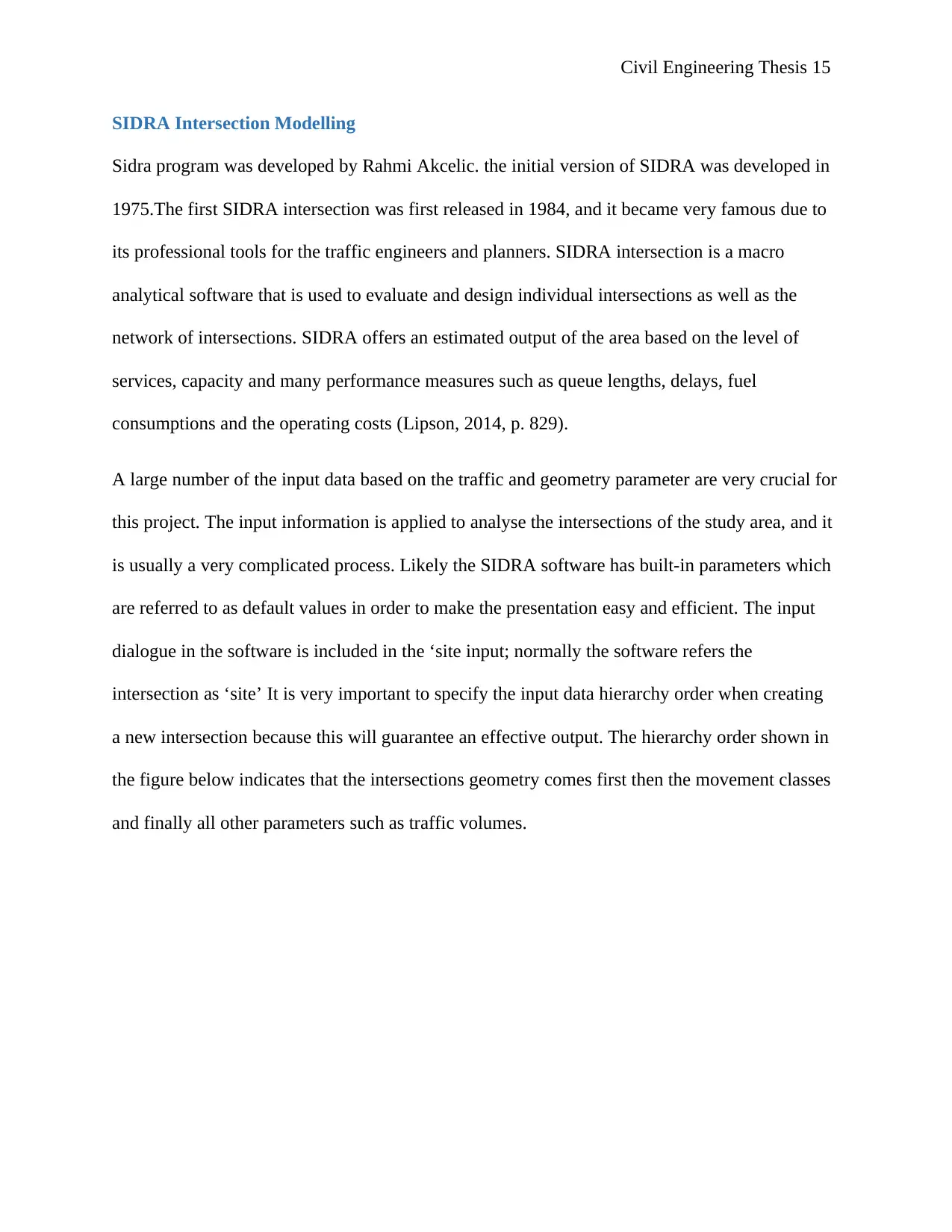
Civil Engineering Thesis 15
SIDRA Intersection Modelling
Sidra program was developed by Rahmi Akcelic. the initial version of SIDRA was developed in
1975.The first SIDRA intersection was first released in 1984, and it became very famous due to
its professional tools for the traffic engineers and planners. SIDRA intersection is a macro
analytical software that is used to evaluate and design individual intersections as well as the
network of intersections. SIDRA offers an estimated output of the area based on the level of
services, capacity and many performance measures such as queue lengths, delays, fuel
consumptions and the operating costs (Lipson, 2014, p. 829).
A large number of the input data based on the traffic and geometry parameter are very crucial for
this project. The input information is applied to analyse the intersections of the study area, and it
is usually a very complicated process. Likely the SIDRA software has built-in parameters which
are referred to as default values in order to make the presentation easy and efficient. The input
dialogue in the software is included in the ‘site input; normally the software refers the
intersection as ‘site’ It is very important to specify the input data hierarchy order when creating
a new intersection because this will guarantee an effective output. The hierarchy order shown in
the figure below indicates that the intersections geometry comes first then the movement classes
and finally all other parameters such as traffic volumes.
SIDRA Intersection Modelling
Sidra program was developed by Rahmi Akcelic. the initial version of SIDRA was developed in
1975.The first SIDRA intersection was first released in 1984, and it became very famous due to
its professional tools for the traffic engineers and planners. SIDRA intersection is a macro
analytical software that is used to evaluate and design individual intersections as well as the
network of intersections. SIDRA offers an estimated output of the area based on the level of
services, capacity and many performance measures such as queue lengths, delays, fuel
consumptions and the operating costs (Lipson, 2014, p. 829).
A large number of the input data based on the traffic and geometry parameter are very crucial for
this project. The input information is applied to analyse the intersections of the study area, and it
is usually a very complicated process. Likely the SIDRA software has built-in parameters which
are referred to as default values in order to make the presentation easy and efficient. The input
dialogue in the software is included in the ‘site input; normally the software refers the
intersection as ‘site’ It is very important to specify the input data hierarchy order when creating
a new intersection because this will guarantee an effective output. The hierarchy order shown in
the figure below indicates that the intersections geometry comes first then the movement classes
and finally all other parameters such as traffic volumes.
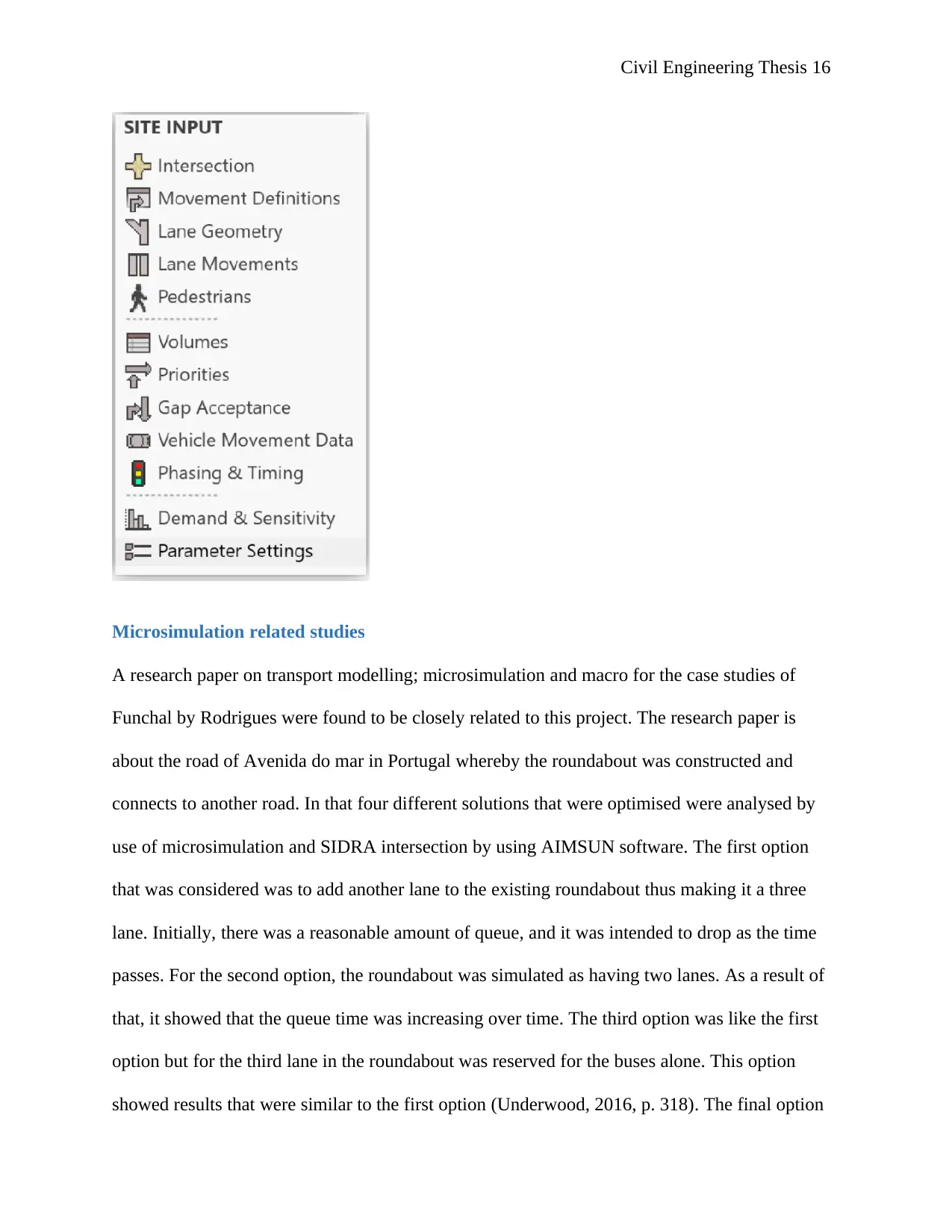
Civil Engineering Thesis 16
Microsimulation related studies
A research paper on transport modelling; microsimulation and macro for the case studies of
Funchal by Rodrigues were found to be closely related to this project. The research paper is
about the road of Avenida do mar in Portugal whereby the roundabout was constructed and
connects to another road. In that four different solutions that were optimised were analysed by
use of microsimulation and SIDRA intersection by using AIMSUN software. The first option
that was considered was to add another lane to the existing roundabout thus making it a three
lane. Initially, there was a reasonable amount of queue, and it was intended to drop as the time
passes. For the second option, the roundabout was simulated as having two lanes. As a result of
that, it showed that the queue time was increasing over time. The third option was like the first
option but for the third lane in the roundabout was reserved for the buses alone. This option
showed results that were similar to the first option (Underwood, 2016, p. 318). The final option
Microsimulation related studies
A research paper on transport modelling; microsimulation and macro for the case studies of
Funchal by Rodrigues were found to be closely related to this project. The research paper is
about the road of Avenida do mar in Portugal whereby the roundabout was constructed and
connects to another road. In that four different solutions that were optimised were analysed by
use of microsimulation and SIDRA intersection by using AIMSUN software. The first option
that was considered was to add another lane to the existing roundabout thus making it a three
lane. Initially, there was a reasonable amount of queue, and it was intended to drop as the time
passes. For the second option, the roundabout was simulated as having two lanes. As a result of
that, it showed that the queue time was increasing over time. The third option was like the first
option but for the third lane in the roundabout was reserved for the buses alone. This option
showed results that were similar to the first option (Underwood, 2016, p. 318). The final option
Secure Best Marks with AI Grader
Need help grading? Try our AI Grader for instant feedback on your assignments.
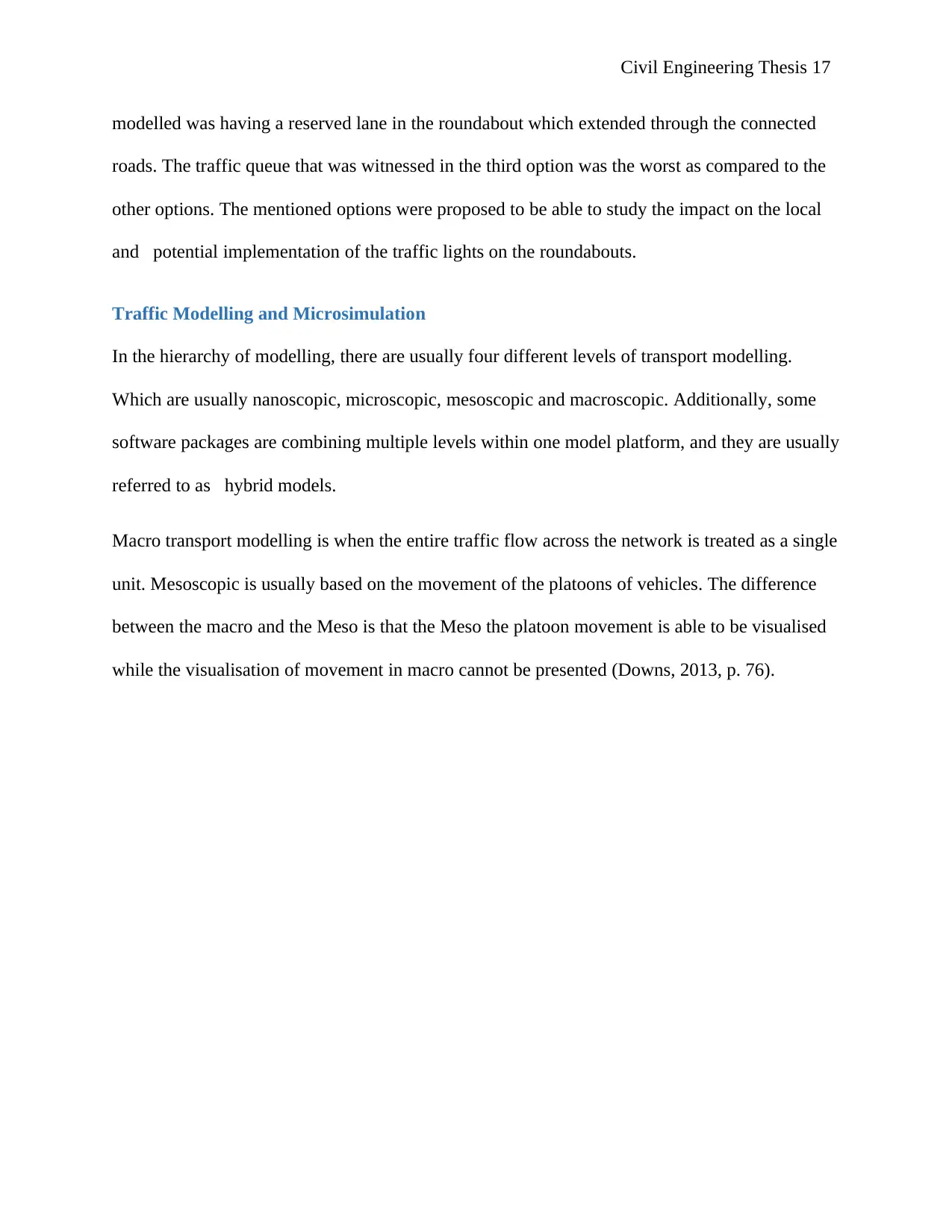
Civil Engineering Thesis 17
modelled was having a reserved lane in the roundabout which extended through the connected
roads. The traffic queue that was witnessed in the third option was the worst as compared to the
other options. The mentioned options were proposed to be able to study the impact on the local
and potential implementation of the traffic lights on the roundabouts.
Traffic Modelling and Microsimulation
In the hierarchy of modelling, there are usually four different levels of transport modelling.
Which are usually nanoscopic, microscopic, mesoscopic and macroscopic. Additionally, some
software packages are combining multiple levels within one model platform, and they are usually
referred to as hybrid models.
Macro transport modelling is when the entire traffic flow across the network is treated as a single
unit. Mesoscopic is usually based on the movement of the platoons of vehicles. The difference
between the macro and the Meso is that the Meso the platoon movement is able to be visualised
while the visualisation of movement in macro cannot be presented (Downs, 2013, p. 76).
modelled was having a reserved lane in the roundabout which extended through the connected
roads. The traffic queue that was witnessed in the third option was the worst as compared to the
other options. The mentioned options were proposed to be able to study the impact on the local
and potential implementation of the traffic lights on the roundabouts.
Traffic Modelling and Microsimulation
In the hierarchy of modelling, there are usually four different levels of transport modelling.
Which are usually nanoscopic, microscopic, mesoscopic and macroscopic. Additionally, some
software packages are combining multiple levels within one model platform, and they are usually
referred to as hybrid models.
Macro transport modelling is when the entire traffic flow across the network is treated as a single
unit. Mesoscopic is usually based on the movement of the platoons of vehicles. The difference
between the macro and the Meso is that the Meso the platoon movement is able to be visualised
while the visualisation of movement in macro cannot be presented (Downs, 2013, p. 76).
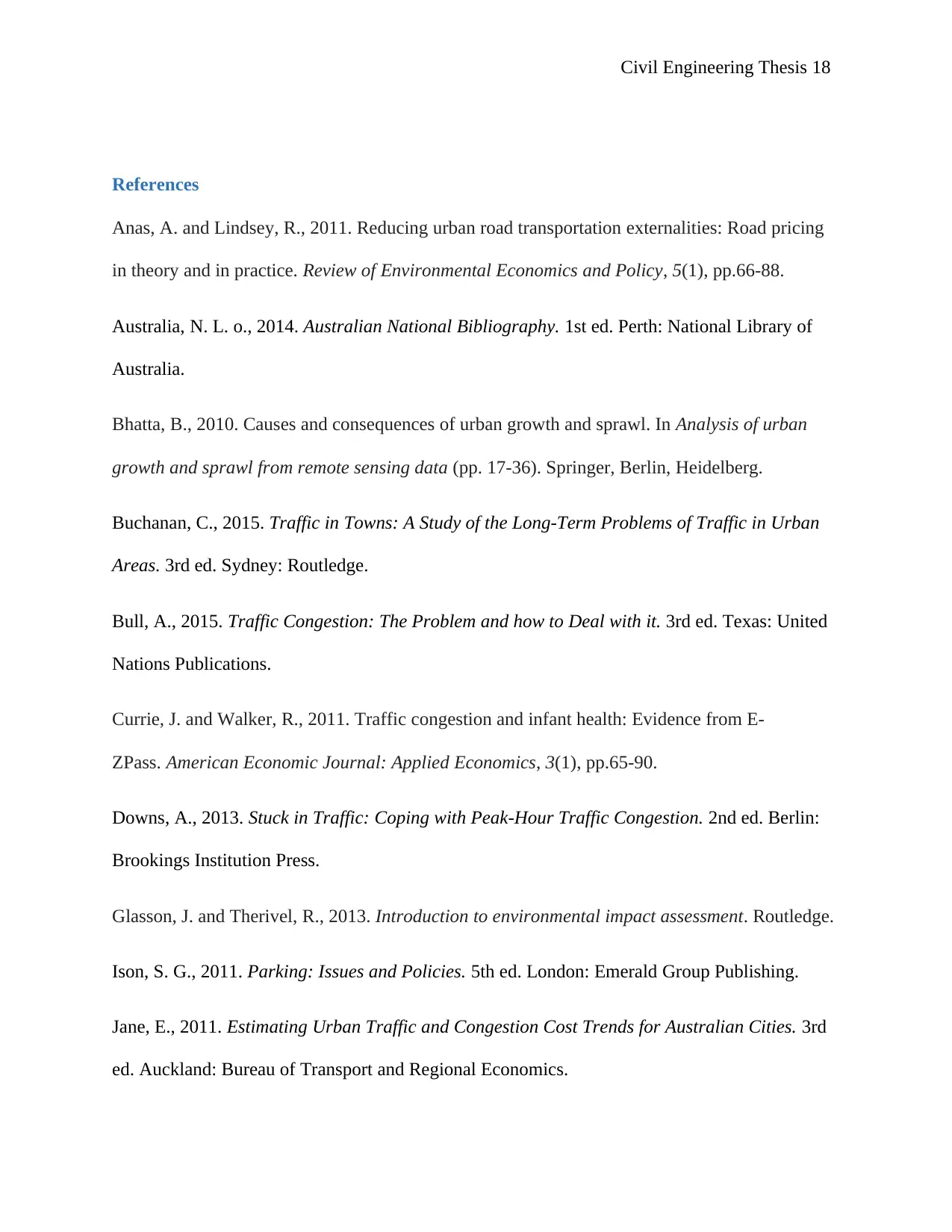
Civil Engineering Thesis 18
References
Anas, A. and Lindsey, R., 2011. Reducing urban road transportation externalities: Road pricing
in theory and in practice. Review of Environmental Economics and Policy, 5(1), pp.66-88.
Australia, N. L. o., 2014. Australian National Bibliography. 1st ed. Perth: National Library of
Australia.
Bhatta, B., 2010. Causes and consequences of urban growth and sprawl. In Analysis of urban
growth and sprawl from remote sensing data (pp. 17-36). Springer, Berlin, Heidelberg.
Buchanan, C., 2015. Traffic in Towns: A Study of the Long-Term Problems of Traffic in Urban
Areas. 3rd ed. Sydney: Routledge.
Bull, A., 2015. Traffic Congestion: The Problem and how to Deal with it. 3rd ed. Texas: United
Nations Publications.
Currie, J. and Walker, R., 2011. Traffic congestion and infant health: Evidence from E-
ZPass. American Economic Journal: Applied Economics, 3(1), pp.65-90.
Downs, A., 2013. Stuck in Traffic: Coping with Peak-Hour Traffic Congestion. 2nd ed. Berlin:
Brookings Institution Press.
Glasson, J. and Therivel, R., 2013. Introduction to environmental impact assessment. Routledge.
Ison, S. G., 2011. Parking: Issues and Policies. 5th ed. London: Emerald Group Publishing.
Jane, E., 2011. Estimating Urban Traffic and Congestion Cost Trends for Australian Cities. 3rd
ed. Auckland: Bureau of Transport and Regional Economics.
References
Anas, A. and Lindsey, R., 2011. Reducing urban road transportation externalities: Road pricing
in theory and in practice. Review of Environmental Economics and Policy, 5(1), pp.66-88.
Australia, N. L. o., 2014. Australian National Bibliography. 1st ed. Perth: National Library of
Australia.
Bhatta, B., 2010. Causes and consequences of urban growth and sprawl. In Analysis of urban
growth and sprawl from remote sensing data (pp. 17-36). Springer, Berlin, Heidelberg.
Buchanan, C., 2015. Traffic in Towns: A Study of the Long-Term Problems of Traffic in Urban
Areas. 3rd ed. Sydney: Routledge.
Bull, A., 2015. Traffic Congestion: The Problem and how to Deal with it. 3rd ed. Texas: United
Nations Publications.
Currie, J. and Walker, R., 2011. Traffic congestion and infant health: Evidence from E-
ZPass. American Economic Journal: Applied Economics, 3(1), pp.65-90.
Downs, A., 2013. Stuck in Traffic: Coping with Peak-Hour Traffic Congestion. 2nd ed. Berlin:
Brookings Institution Press.
Glasson, J. and Therivel, R., 2013. Introduction to environmental impact assessment. Routledge.
Ison, S. G., 2011. Parking: Issues and Policies. 5th ed. London: Emerald Group Publishing.
Jane, E., 2011. Estimating Urban Traffic and Congestion Cost Trends for Australian Cities. 3rd
ed. Auckland: Bureau of Transport and Regional Economics.
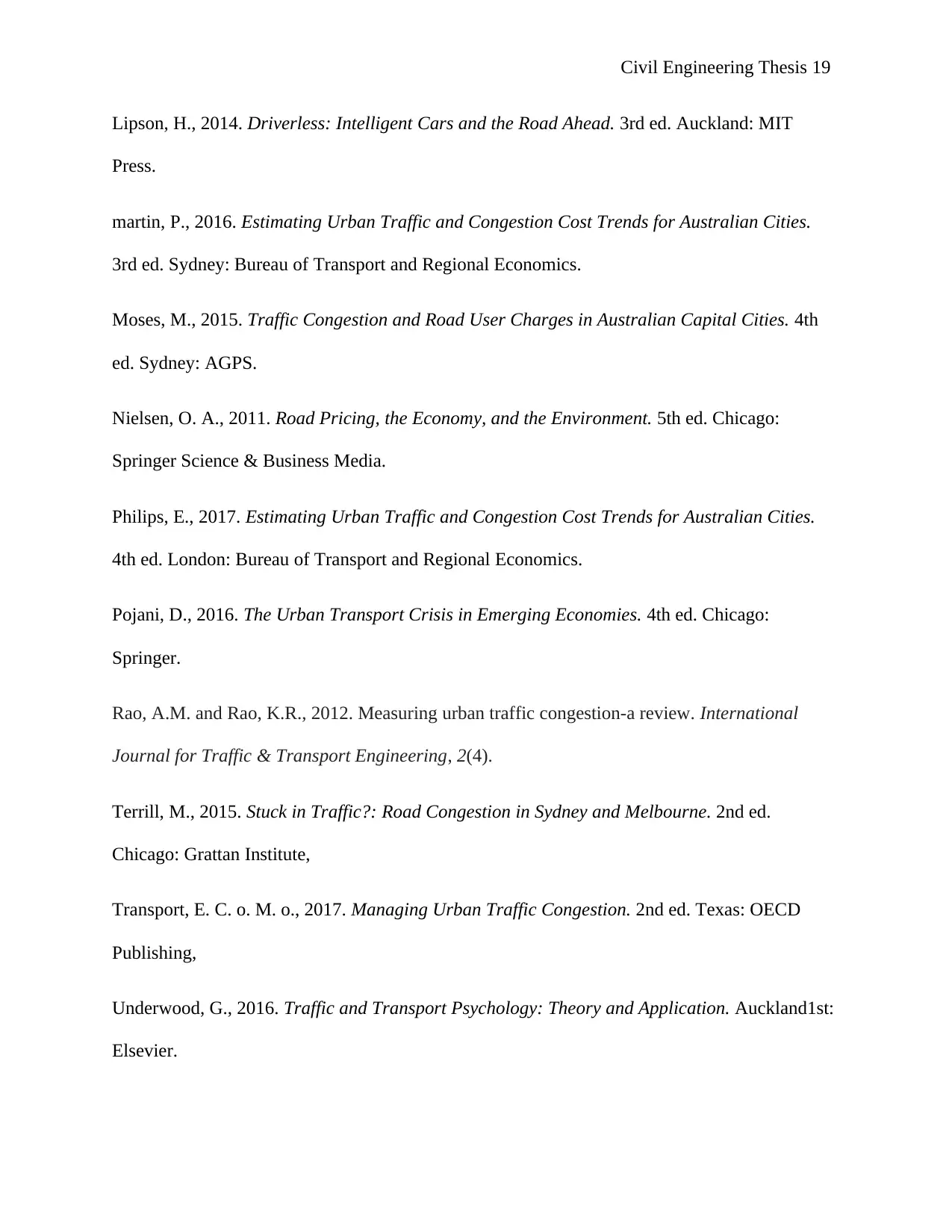
Civil Engineering Thesis 19
Lipson, H., 2014. Driverless: Intelligent Cars and the Road Ahead. 3rd ed. Auckland: MIT
Press.
martin, P., 2016. Estimating Urban Traffic and Congestion Cost Trends for Australian Cities.
3rd ed. Sydney: Bureau of Transport and Regional Economics.
Moses, M., 2015. Traffic Congestion and Road User Charges in Australian Capital Cities. 4th
ed. Sydney: AGPS.
Nielsen, O. A., 2011. Road Pricing, the Economy, and the Environment. 5th ed. Chicago:
Springer Science & Business Media.
Philips, E., 2017. Estimating Urban Traffic and Congestion Cost Trends for Australian Cities.
4th ed. London: Bureau of Transport and Regional Economics.
Pojani, D., 2016. The Urban Transport Crisis in Emerging Economies. 4th ed. Chicago:
Springer.
Rao, A.M. and Rao, K.R., 2012. Measuring urban traffic congestion-a review. International
Journal for Traffic & Transport Engineering, 2(4).
Terrill, M., 2015. Stuck in Traffic?: Road Congestion in Sydney and Melbourne. 2nd ed.
Chicago: Grattan Institute,
Transport, E. C. o. M. o., 2017. Managing Urban Traffic Congestion. 2nd ed. Texas: OECD
Publishing,
Underwood, G., 2016. Traffic and Transport Psychology: Theory and Application. Auckland1st:
Elsevier.
Lipson, H., 2014. Driverless: Intelligent Cars and the Road Ahead. 3rd ed. Auckland: MIT
Press.
martin, P., 2016. Estimating Urban Traffic and Congestion Cost Trends for Australian Cities.
3rd ed. Sydney: Bureau of Transport and Regional Economics.
Moses, M., 2015. Traffic Congestion and Road User Charges in Australian Capital Cities. 4th
ed. Sydney: AGPS.
Nielsen, O. A., 2011. Road Pricing, the Economy, and the Environment. 5th ed. Chicago:
Springer Science & Business Media.
Philips, E., 2017. Estimating Urban Traffic and Congestion Cost Trends for Australian Cities.
4th ed. London: Bureau of Transport and Regional Economics.
Pojani, D., 2016. The Urban Transport Crisis in Emerging Economies. 4th ed. Chicago:
Springer.
Rao, A.M. and Rao, K.R., 2012. Measuring urban traffic congestion-a review. International
Journal for Traffic & Transport Engineering, 2(4).
Terrill, M., 2015. Stuck in Traffic?: Road Congestion in Sydney and Melbourne. 2nd ed.
Chicago: Grattan Institute,
Transport, E. C. o. M. o., 2017. Managing Urban Traffic Congestion. 2nd ed. Texas: OECD
Publishing,
Underwood, G., 2016. Traffic and Transport Psychology: Theory and Application. Auckland1st:
Elsevier.
Paraphrase This Document
Need a fresh take? Get an instant paraphrase of this document with our AI Paraphraser
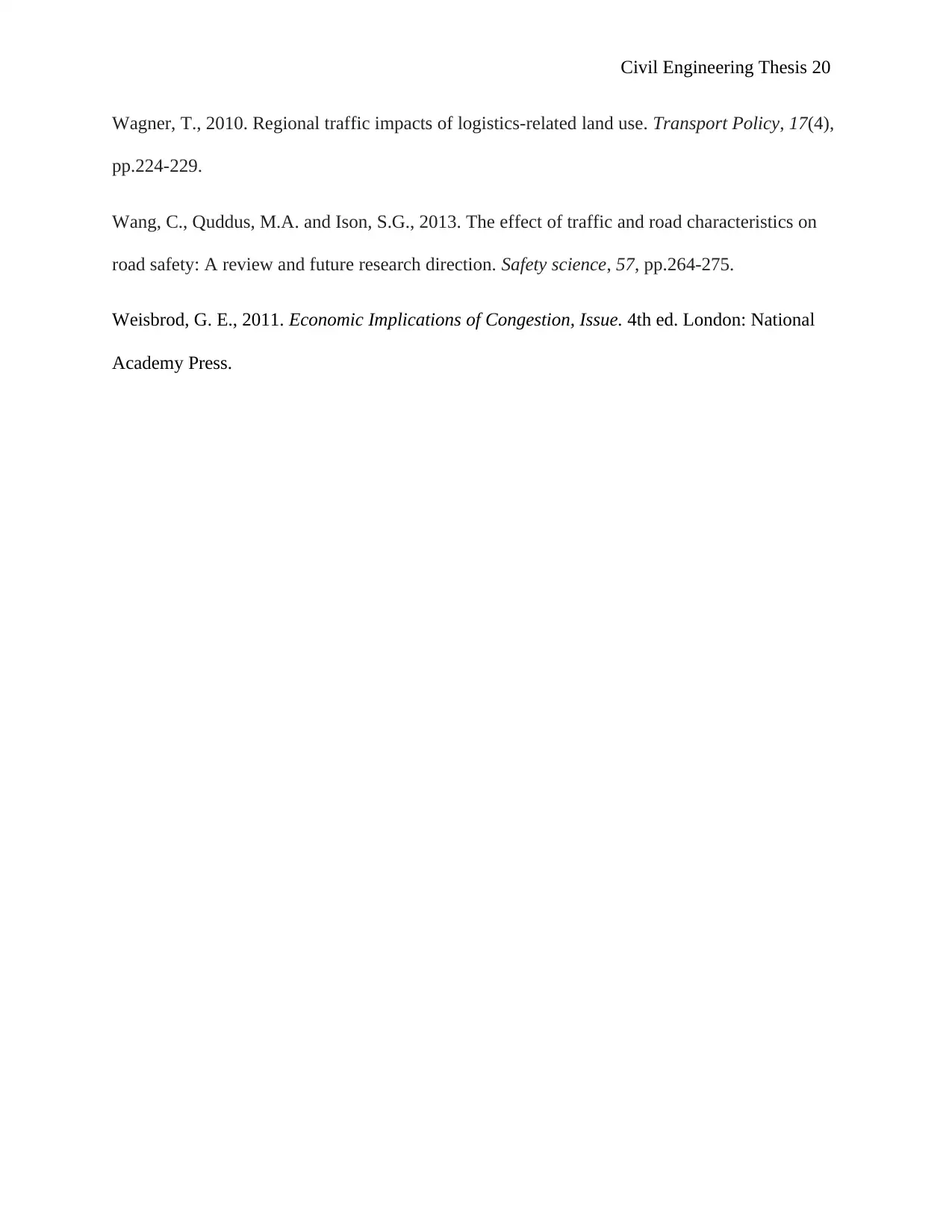
Civil Engineering Thesis 20
Wagner, T., 2010. Regional traffic impacts of logistics-related land use. Transport Policy, 17(4),
pp.224-229.
Wang, C., Quddus, M.A. and Ison, S.G., 2013. The effect of traffic and road characteristics on
road safety: A review and future research direction. Safety science, 57, pp.264-275.
Weisbrod, G. E., 2011. Economic Implications of Congestion, Issue. 4th ed. London: National
Academy Press.
Wagner, T., 2010. Regional traffic impacts of logistics-related land use. Transport Policy, 17(4),
pp.224-229.
Wang, C., Quddus, M.A. and Ison, S.G., 2013. The effect of traffic and road characteristics on
road safety: A review and future research direction. Safety science, 57, pp.264-275.
Weisbrod, G. E., 2011. Economic Implications of Congestion, Issue. 4th ed. London: National
Academy Press.
1 out of 20
Related Documents
Your All-in-One AI-Powered Toolkit for Academic Success.
+13062052269
info@desklib.com
Available 24*7 on WhatsApp / Email
![[object Object]](/_next/static/media/star-bottom.7253800d.svg)
Unlock your academic potential
© 2024 | Zucol Services PVT LTD | All rights reserved.
